Vol. 104 Issue 1215
IMO 2023 GHG: Outside politics looms Subsea Mining: To boldly go PBST TCP: New radial generation Data silos: Port/voyage optimisation

ALSO IN THIS ISSUE: CCS feature | Sold State Batteries |
Index

By pairing our technical knowledge with the latest digital technologies, ABS leads the maritime industry in providing customers with innovative, tailored sustainability solutions that deliver results.








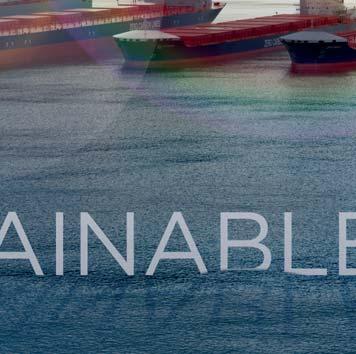


Learn more today at www.eagle.org/sustainability.
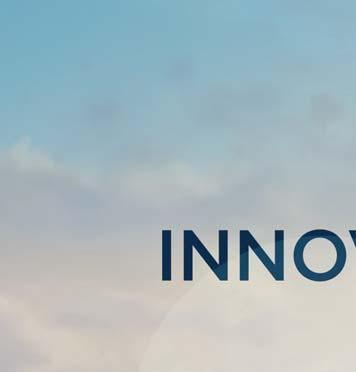
2023
KC-2 LNG debut | DNV’s VTI
JULY/AUGUST
Green Ports and Shipping Congress will identify and prioritise the areas that ports-based organisations and shipping companies need to collaborate on to reduce emissions.

Green Ports & Shipping Congress will cover a range of topics addressing the aspects of energy transition plans and


operations and ships.
Sessions and streams will focus on the required infrastructure, alternative fuel options/bunkering, technical solutions and how these align with the shipping lines and logistics chains.
It is a must-attend event for policy makers, ports and terminal operators, shipping companies, shippers and logistics companies, fuel & propulsion providers, decarbonisation clusters.

Media partners: PORTSTRATEGY INSIGHTFOR PORTEXECUTIVES GREENPORT INSIGHTFOR PORTEXECUTIVES MOTORSHIP MARINETECHNOLOGY THE Visit www.greenseascongress.com Supporters:
For further information about speaking, sponsoring or attending as a delegate,
the Events
Register your interest now!
contact
team on +44 1329 825335
FEATURES 4 6
14 New KC-2 debut
An upgraded version of South Korea’s home-grown LNG cargo containment solution has had its first application in a newly-delivered bunker tanker.

15 HiMSEN H2 engine reveal
South Korea’s first home-grown, mixed-fuel LNG/hydrogen engine has been demonstrated for the first time to potential buyers.
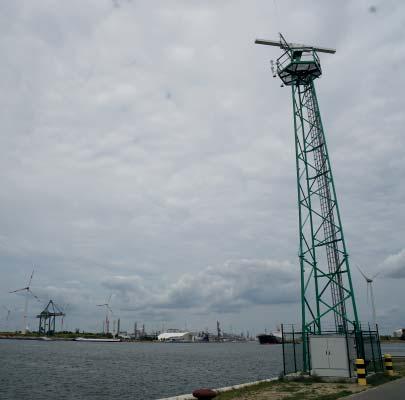
35
State of play
Toyota’s plans to introduce commercial solid-state production by 2027 is just one of several advances in battery chemistry aiming to boost power density, and increase longevity and C rates.
36 REGULARS
6 Regulation
The IMO has adopted a revised strategy to reduce greenhouse gas emissions from international shipping, targeting net zero emissions by 2050.

36 Design for Performance
Researchers in the SeaTech Consortium testing a dynamic wing and new engine control technology expect the project to lead to emissions reductions of 30% or more when running on LNG.
38
Ship Description
The NYK Group has taken delivery of the initial vessels in a major programme of LNG-fuelled pure car/ truck carrier (PCTC) construction, writes David Tinsley.

14 New combustion concept
Preliminary field tests of a new combustion concept being developed by the SeaTech Consortium support expectations of a 10% reduction in GHG emissions, and potential wider applicability.
18 New radial generation
PBST’s new generation of radial turbochargers are targeting single stage pressure ratios far above 6 and best-in-class specific mass flow rates, Wendy Laursen hears.
24 Measure for measure
DNV is launching a Recommended Practice (RP) offering to evaluate technical performance, which unlike the CII Index will not be swayed by the impact of weather, speed, and loading condition.
28 Purity key to containment
Designers of onboard CO2 capture technologies need to account for purity levels when designing containment systems, notes Rupert Hare, CEO of Houlder.
30 Lowest hanging data flows
A number of developers are ship’s propulsion system to the next port of call, and a growing number of companies are collaborating on making the most of it to reduce emissions.
The Motorship’s Propulsion and Future Fuels Conference will take place this year in Hamburg, Germany. Stay in touch at propulsionconference.com
Social Media Linkedin Facebook Twitter YouTube Online motorship.com 5 Latest news 5 Comment & analysis 5 Industry database 5 Events Weekly E-News Sign up for FREE at: www.motorship.com/enews For the latest news and analysis go to www.motorship.com JULY/AUGUST 2023 | 3 CONTENTS JULY/AUGUST 2023 NEWS
30 44TH
DEBUT FOR REVISED KOREAN LNG TANK SYSTEM
VIEWPOINT
NICK EDSTROM | Editor nedstrom@motorship.com
Barriers to implementation
While sceptics may quibble about the specific details, and there remain unresolved questions about what a net-zero decarbonised future for international shipping sector will look like, we should recognise what an outstanding achievement agreeing the IMO’s 2023 Greenhouse Gas Strategy was, given the extraordinary pressures under which the delegates were operating.
The agreement clearly sets a direction of travel for the industry, and the agreement of targets for the introduction of low and zero emission fuel by 2030 addresses some of the chicken and egg related concerns connected with big ticket investments to develop low and zero carbon fuel supplies.
The effects have been seen in the container market, where East Asian operators have begun to follow the lead of European container operators to invest in methanol-fuelled newbuilds. We can safely assume that demand for dual-fuel retrofit projects will pick up in the coming period.
However, large systemically important container line operators are responding to customer pressures (an area in which Scope 3 emissions outweighs youthful environmentalist consumers), and regional environmental regulation developments (the EU’s CBAM), as much as regulatory pressures.
Other sectors of the international shipping sector are lagging well behind in terms of adopting new fuels, both because of pervasive concerns about fuel availability and lingering hopes that advances in propulsion technology or emissions reduction technology (carbon capture!) will help to delay the inevitable.
I note that sector-specific concerns about the potential impact of higher decarbonisation fuel costs on logistics costs for existing trades (including Front Haul bulk trades to China) are likely to have influenced national attitudes towards adopting science-based targets at MEPC 80.
As such, the importance of developing a package of mid-term measures that will be able to incentivise the shipping industry to decarbonise will be the defining discussion in the coming period.
An interesting area that has not received adequate attention will be the need to incentivise efficiency improvements in existing vessels servicing trades that are likely to enter into long term decline well before 2050, such as the seaborne thermal coal market.
Fortunately, the incoming new IMO new secretary-general, Arsenio Antonio Dominguez Velasco, has a solid understanding of the decarbonisation brief, having served as chair of the MEPC committee. He will need all of his political experience, as outside interests are likely to intrude on maritime discussions related to decarbonisation to an ever greater extent.
The politicisation of the maritime decarbonisation agenda both within individual nations and regional blocs - the decarbonisation agenda is becoming increasingly politicised in Europe - and as a source of disagreement between the major trading nations (and the EU), is likely to intensify over the coming years.
It is a measure of the interconnected nature of the decarbonisation agenda that changes of government policy agendas can impact funding and the viability of low carbon and zero carbon fuel projects. Biofuel suppliers will be watching the formation of the next Dutch government with interest, for example.

An upgraded version of South Korea’s home-grown LNG cargo containment solution has had its first application in a newlydelivered bunker tanker.

The technology initially developed between 2004 and 2014 that gave rise to the KC-1 membrane system has now been enhanced and introduced as the KC-2 design. Realising the further stage of R&D implemented in 2017, the KC-2 solution has made its debut in the 7,500m3-capacity LNG bunker tanker Blue Whale.
Built at the Ulsan complex of HD Hyundai Heavy Industries over a two-year period, the 97m Blue Whale was handed over last month to Korea LNG Bunkering (KOLB), a subsidiary of Korea Gas Corporation (KOGAS). KOLB has entrusted the vessel’s management and operation to Hyundai LNG Shipping.
KOLB had been selected by the Korean Ministry of Trade, Industry and Energy to front the national LNG Bunkering Vessel Construction Support Project in 2020, and the company ordered the ship with the benefit of a government subsidy of Won15bn ($11.5m). The overall contract price amounted to Won55.3b n($42m).
The nature and realisation of the newbuild scheme is regarded as a further achievement in the strategy of localising LNG cargo containment technology, given the Korean shipbuilding industry’s pre-eminent position in the global LNG carrier construction market and its reliance and expenditure on licensed foreign cargo system designs. Once the KC-2 solution has been verified in service in the Blue Whale, the commercialisation process will be extended to the LNGC sector.
The long-crafted, indigenous
KC-1 system came to fruition during 2018 through its embodiment in two 174,000m3 LNGCs completed by Samsung Heavy Industries for SK Shipping, the SK Serenity and SK Spica.
The KC-1 technology has subsequently been used to effect in two small-scale LNGCs of 7,500m3 capacity, which are chartered to KOGAS. Since respective handovers in September 2019 and January 2020, the vessels have been employed either shipping cargoes from the Tongyeong LNG terminal to Jeju Island in the Korea Strait, or undertaking direct bunker transfers.
While the efficiency benefits promised by the KC-1 membrane solution provided the technical foundation for its development and adoption, the motivation for the creation of the system was the financial benefit it would afford domestic shipbuilders in not having to pay licence fees for using foreign, core technologies. A few years ago, such payments were understood to equate to around 5% of ship price, and it was indicated that yards would be able to save around 60% of royalty costs by adopting KC-1.
Strengthening technological self-reliance in this sphere therefore has the potential to sharpen Korean shipbuilding competitiveness and consolidate its position as the world’s most prolific producer of LNG carriers. Currently, the preponderance of such vessels from Korean yards employ the membrane design series originated by Gaztransport & Technigaz(GTT).
NEWS REVIEW 4 | JULY/AUGUST 2023 For the latest news and analysis go to www.motorship.com
8 Blue Whale embodies South Korea’s newly-developed KC-2 cargo system
South Korea’s first home-grown, mixed-fuel LNG/hydrogen engine has been demonstrated for the first time to potential buyers. The versatile fourstroke design has been jointly developed by HD Hyundai Heavy Industries Engine & Machinery Division(HHI-EMD) and HD KSOE in keeping with decarbonisation goals, and will augment the group’s HiMSEN portfolio.
Based on HiMSEN LNG dual-fuel engine technology, the new model will provide users with the option to selectively use and switch between diesel oil, LNG and an LNG/hydrogen mixture. Operating in the latter mode will realise reductions in greenhouse gas emissions such as CO2 and unburnt methane.
The recent demonstration of the 1,500kW test engine at HD
KOREA PROMOTES HYDROGEN CO-FIRING ENGINE
engine offers first-rate loadfollowing behaviour, adjusting output precisely in accordance with changes in electrical load, be it as a marine auxiliary installation or in a landside power plant setting. Moreover, the multi-fuel combustion engine promises a faster start-up time and longer lifespan than fuel cells.
HHI’s
complex, in front of representatives from the shipping and power generation sectors, confirmed stable LNG/ hydrogen co-firing performance while satisfying IMO Tier III NOx
regulations without the need for aftertreatment solutions.
The manufacturer claims the
Following a test campaign last September, HD HHI obtained approval in principle(AiP) for its HiMSEN LNG/hydrogen mixed fuel engine safety concept. In the meantime, HHI is continuing research into a 100% hydrogen engine, with a view to an outcome by 2025.
New injection technology lowers NOx emissions of MAN 10.6 engines
MAN Energy Solutions has developed a new sequential fuel injection system to optimize the emissions performance of its new high efficiency 10.6 engines, and researchers shared details of its development at CIMAC 2023.
Currently the new large 2-stroke 10.6 engine types that have been developed by MAN are based on the S50ME-C9.7 and S60ME-C10.5 engine and include 50, 60, 80 and 95cm bore. The aim is to continue boosting the efficiency of MAN’s single-fuel engines which currently make up about half of its engine sales.
The high engine efficiency of the new engine necessitated a NOx solution to ensure the engine remained Tier II compliant. The production of NOx emissions
HiMSEN licence first
is related to fuel consumption and the mechanical and thermal load of the combustion chamber. Each of these parameters is inter-related, and the sequential fuel injection optimisation involves carefully timed sequencing of each injector. The concept is able to reduce NOx formation, and when combined with higher maximum cylinder pressures, fuel oil consumption is also reduced. The lower rate of injected energy achieved reduces NOx formation with only a small fuel oil consumption penalty.
The process is electronically controlled, with fuel booster injection valves hydraulically operated and controlled by window injection valve actuation. This ensures precise control for
First Panamanian SG
the system as fuel enters via pipes to a sleeve in the cylinder cover. A hydraulic cylinder unit sequential replaces the existing hydraulic cylinder unit as it no longer requires a booster. The new unit takes up half the space.
The exhaust valves and actuators are similar to those in existing hydraulic cylinder units and fuel injection valve actuators, but they are now located on the manoeuvring side of the cylinder cover rather than being placed on the baseplate.
The overall increased maximum combustion pressure of the 10.6 has led to reinforcement of both moving and structural engine parts, but this has been achieved with minimal change to engine room
Maersk feeder 1st
layout. The cylinder distance and height of interfaces are maintained. Main bearing size remains unchanged, as the main bearing zero is now introduced on the fore end of the engine to avoid having a bearing edge load that is too high. The crankpin bearing has increased diameter and width, and main bearing support side machining has now been introduced, along with crosshead bearing changed from white metal to tin-aluminium.
MAN says it is continuously pursuing the best possible efficiency and the lowest possible carbon footprint for its engines.
BRIEFS
Evergreen DF orders
A joint venture between HD Korea Shipbuilding & Offshore Engineering Co. and two Saudi Arabian partners have begun building a new plant in Ras Al-Khair. The new 150,000 m2 production plant is the first in Saudi Arabia capable of locally producing large-bore and medium speed diesel engines. The plant represents the first time that HD Hyundai will licence the manufacture of its HiMSEN 4-stroke, medium speed engines outside Korea.
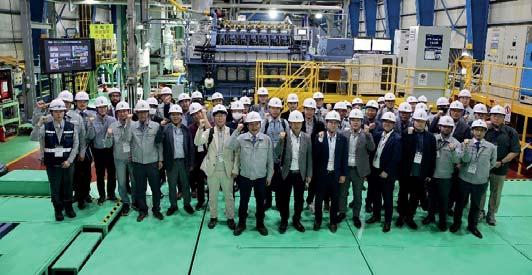
Arsenio Antonio Dominguez
evasion
Velasco was elected as the next secretary-general of the IMO in mid July and will take up the post on 1 January 2024. He has been elected for a four-year period until 2027, with the possibility of a fouryear extension. The former Ambassador and Permanent Representative of Panama to the IMO and Chairman of the MEPC, will become the first Panamanian and Latin American to serve as secretary-general.
Maersk has taken delivery of the company’s first container vessel capable of operating on methanol. The 2,100 teu vessel was handed over by Hyundai Mipo Dockyard and Hyundai Heavy Industries on 10 July. The vessel is the first container vessel to be fuelled by methanol, and is expected to be the first methanol-powered vessel to be fuelled by green methanol in the world. The vessel is expected to arrive in Copenhagen in September.
An Evergreen Shipping subsidiary has ordered 16 16,000 teu container vessels from SHI, and 8 vessels from Nihon Shipyard for around US$180-210 million each. The vessels will be equipped with dual-fuel engines capable of operating on methanol. The Taiwanese based container line operator has previously noted that the vessels are expected to operate on routes between Asia and Europe.
‘‘ NEWS REVIEW
Ports must be able to check the background of all vessels and show bodies such as OFAC that they have the technology to screen ships for suspected sanctions
8 LNG/hydrogen engine demonstration at Ulsan
Ulsan
For the latest news and analysis go to www.motorship.com JULY/AUGUST 2023 | 5
Credit: HD HHI).
2023 GHG STRATEGY LIFTS SHIPPING’S GREEN AMBITION
The International Maritime Organization (IMO) has adopted a revised strategy to reduce greenhouse gas emissions from international shipping.
The member States of the IMO, meeting at the Marine Environment Protection Committee (MEPC 80), have adopted the 2023 IMO Strategy on Reduction of GHG Emissions from Ships, with enhanced targets to tackle harmful emissions.
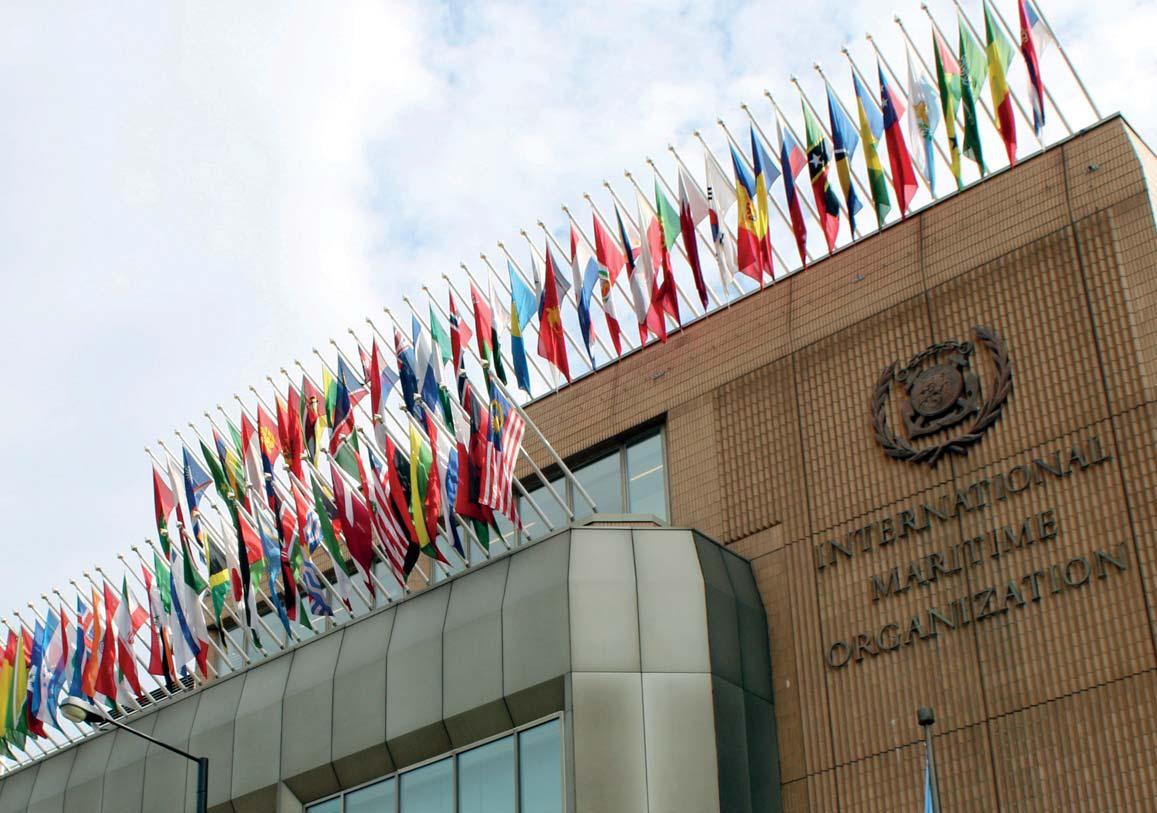
The revised IMO GHG Strategy includes an enhanced common ambition to reach net-zero GHG emissions from international shipping close to 2050, a commitment to ensure an uptake of alternative zero and near-zero GHG fuels by 2030, as well as indicative checkpoints for 2030 and 2040. The Strategy was adopted unanimously.
2023 IMO Strategy on Reduction of GHG Emissions from Ships
The 2023 IMO Strategy on Reduction of GHG Emissions from Ships (2023 IMO GHG Strategy) was adopted with improvements to the levels of ambition along with newly established indicative checkpoints towards GHG emission reduction from international shipping as shown in the following table. It is also noted that the reduction of the total annual GHG emissions by 2030 and 2040 were agreed as indicative checkpoints to reach net-zero GHG reduction target for 2050. The Strategy is subject to a review every five years.
The 2023 IMO GHG Strategy agreed a multi-faceted approach towards reducing environmental emissions from the international shipping sector.
It intends to review the EEDI requirements for ships with the aim of tightening the targets, in order to further reduce the carbon intensity of shipping.
While the existing CO2 emissions per transport work target of a 40% reduction by 2030 (against a 2008 baseline) was left unchanged, a new target of a 70% reduction (with an ambition to achieve an 80% reduction) was introduced for 2040.
One of the most potentially important innovations was the introduction of a requirement for at least 5% of energy used by international shipping to be supplied by zero or net-zero GHG emission technologies, fuels or energy sources by 2030. This ambition includes an ambition for up to 10% of energy used to be supplied by such sources.
Finally, the 2023 IMO GHG Strategy increases the level of ambition within the shipping sector, calling for GHG emissions from international shipping to peak as soon as possible and to reach net-zero GHG emissions by or close to 2050.
Well to wake LCA approach
As expected, the meeting recognised that GHG emissions produced during the manufacturing and distribution processes of low/zero-carbon fuels should be taken into account when comparing different fuels. The meeting also recognised that a fair comparison between fuels would also take into account other greenhouse gases apart from CO2,
MEPC80 6 | JULY/AUGUST 2023 For the latest news and analysis go to www.motorship.com
8 The IMO has adopted a revised strategy to reduce greenhouse gas emissions from international shipping
such as methane (CH4) and nitrous oxide (N2O), both of which have a high effect on global warming that NOx or SOx.
The meeting reviewed and adopted a set of draft Guidelines on Life Cycle GHG Intensity of Marine Fuels (LCA Guidelines) produced by a correspondence group to permit the assessment of GHG emission intensity from marine fuels, taking into account its manufacturing, distribution, and use onboard ships.
While the LCA Guidelines provide a general framework on the calculation method of GHG emission intensity including CO2, CH4 and N2O, there was no agreement on a number of technical issues, including the establishment of comprehensible regulations on GHG emission intensity calculation procedures and verification/certification procedures. The establishment of default emission factors, as well as some biomass related adjustments, will be addressed in an Expert Workshop.
Basket of candidate mid-term GHG reduction measures
As expected, discussion about the potential mid-term measures resulted in a number of shortlisted schemes that will be identified for further development.
A number of different schemes were put forward, including a universal greenhouse gas levy (or carbon levy), an annual ratchet for GHG emissions intensity, as well as a feebate mechanism.
A timeline for the mid-term measures specifying the adoption of specific measures by 2025 followed by entry into force by 2027 has been incorporated into the 2023 IMO GHG Strategy.
The candidate economic elements will undergo a comprehensive impact assessment (CIA) on the combination of technical and economical elements of respective basket of measures, with a view to facilitating the finalisation of the basket of measures.
The 2023 GHG Strategy states that a basket of candidate measure(s), delivering on the reduction targets, should be developed and finalized comprised of both:
– a technical element, namely a goal-based marine fuel standard regulating the phased reduction of the marine fuel’s GHG intensity; and
– an economic element, on the basis of a maritime GHG emissions pricing mechanism.
Next Steps
The 2023 Strategy sets out a timeline towards adoption of the basket of measures and adoption of the updated 2028 IMO GHG Strategy on reduction of GHG emissions from ships:
5 MEPC 81 (Spring 2024) - Interim report on Comprehensive impact assessment of the basket of candidate mid-term measures/Finalization of basket of measures
5 MEPC 82 (Autumn 2024) - Finalized report on Comprehensive impact assessment of the basket of candidate mid-term measures
5 MEPC 83 (Summer 2025) - Review of the short-term measure to be completed by 1 January 2026
5 MEPC 84 (Spring 2026) - Approval of measures / Review of the short-term measure (EEXI and CII) to be completed by 1 January 2026
5 Extraordinary one or two-day MEPC (six months after MEPC 83 in Autumn 2025) - Adoption of measures
Target dates:
5 MEPC 85 (Autumn 2026)
5 16 months after adoption of measures (2027) - Entry into force of measures
5 MEPC 86 (Summer 2027) - Initiate the review of the 2023 IMO GHG Strategy
Target year 2018 ambition2023 ambition
2030
6 To reduce CO2 emissions per transport work by at least 40%
6 To reduce CO2 emissions per transport work by at least 40%
6 To reduce total annual GHG emissions by at least 20% (striving for 30%)
6 Uptake of zero GHG emission fuels etc. to represent at least 5% of the energy used (striving for 10%)
2040
2050
6 To reduce CO2 emissions per transport work by at least 70%
6 To reduce total annual GHG emissions by at least 50%
6 To reduce total annual GHG emissions by at least 70% (striving for 80%)
6 To reach net-zero GHG emissions by or around 2050 at the latest
By
6 To reach zero GHG
5 MEPC 87 (Spring 2028)
5 MEPC 88 (Autumn 2028) - Finalization of the review of the 2023 IMO GHG Strategy with a view to adoption of the 2028 IMO Strategy on reduction of GHG emissions from ships.

Life cycle GHG assessment guidelines adopted
The MEPC adopted Guidelines on life cycle GHG intensity of marine fuels (LCA guidelines) for consideration and adoption. The LCA guidelines allow for a Well-to-Wake calculation, including Well-to-Tank and Tank-to-Wake emission factors, of total GHG emissions related to the production and use of marine fuels.
Interim guidance on the use of biofuels
The MEPC approved an MEPC circular on Interim guidance on the use of biofuels under regulations 26, 27 and 28 of MARPOL Annex VI (DCS and CII).
Marine Environment Protection Committee (MEPC 80)
The Marine Environment Protection Committee (MEPC) addresses environmental issues under IMO’s remit. This includes the control and prevention of ship-source pollution covered by the MARPOL treaty, including oil, chemicals carried in bulk, sewage, garbage and emissions from ships, including air pollutants and greenhouse gas emissions. Other matters covered include ballast water management, antifouling systems, ship recycling, pollution preparedness and response, and identification of special areas and particularly sensitive sea areas.
8 The introduction of zero GHG fuel targets by 2030 will incentivise the development of alternative fuel supplies
8 The introduction of milestone targets for 2030 and 2040, with higher ambitions, lifts the industry’s decarbonisation ambitions
MEPC80 For the latest news and analysis go to www.motorship.com JULY/AUGUST 2023 | 7
end-2099
emissions
TWO-STROKE ENGINES
1st ME-GA ENGINE WITH INDIVIDUAL CYLINDER CONTROL
The first low-pressure ME-GA engine to be equipped with a new engine control feature, ‘ME-GA-opti’, successfully completed LNG gas trials in South Korea in July, MAN ES has announced
The vessel’s engine-control system is the first to be equipped with a new control feature called ‘ME-GA opti’, which MAN ES states will allow optimal engine operation through individual cylinder control.
The MAN B&W ME-GA engine has been installed on an LNG carrier under construction by Samsung Heavy Industries (SHI) for an unspecified shipowner. The dual-fuel vessel, which was ordered in Q2 2021 and is scheduled for delivery in July 2023, is equipped with Exhaust Gas Recirculation (EGR) for emission reduction.
The introduction of individual cylinder control into the MEGA engine control system is expected to lead to improvements in the performance of the engine platform. The solution is expected to improve specific gas consumption during the average service life of an LNG carrier by “several percentage points”.
The algorithms used by the ‘ME-GA-opti’ ensure, in an unprecedented way, that the two-stroke Otto engines’ combustion process runs as close to its designed optimum as possible in service.
One of the ways in which the ME-GA-opti does this is by reducing the influences of ambient temperature, pressure and humidity, all of which can influence Otto-cycle engines’ operation. The MEGA-opti is able to adapt the engine’s running conditions as the combustion moves towards the pre-ignition limit, reducing fuel-ratio control activation.
The solution has the capacity to match ideal running conditions for the engine even in the toughest weather conditions and without oil activation.
First ME-GA gas trial
The announcement of the completion of sea trials by the first vessel equipped with a ME-GA-opti came a few days after the first vessel to be propelled by a MAN B&W MEGA engine completed its own sea and gas trials in Korea.
The MAN B&W engine was installed on an LNG carrier built by Hyundai Samho Heavy Industries (HSHI) for Norwegian shipping company, Knutsen OAS Shipping. The engine

In the adverse sea conditions that these vessels very often find themselves in, engines operate in far from ideal conditions. Prior to the development of ME-GA-opti, the engine would rely on oil operation to stabilise combustion in such rough weather.
Oil activation is a feature still found in the engine-control software, but its usage is expected to be significantly limited from now on, meeting charterers’ preference for maximised gas operation for LNG carriers.
itself was built by MAN licensee HHI-EMD.
Thomas S. Hansen, Head of Promotion and Customer Support, MAN Energy Solutions, said: “We have had more than 260 orders for the ME-GA since its launch in May 2021 and our orderbook contains ME-GA engine orders for ship deliveries stretching all the way into 2027. EGR as standard enables the ME-GA to significantly reduce emissions, while simultaneously improving fuel
8 An LNG carrier for Knutsen OAS Shipping has just successfully passed gas trials with a ME-GA engine (pictured)
fficiency and operation in both gas and fuel-oil operation.”
e
The Motorship notes that the volume of orders for the new MAN B&W ME-GA engine platform since MAN ES' latest addition was unveiled in March 2021 is testament to strong customer demand. It is significant that two of the first vessels to be powered by ME-GA engines were completed by major shipyards in Korea a few days apart.
8 | JULY/AUGUST 2023 For the latest news and analysis go to www.motorship.com
‘‘
The solution has the capacity to match ideal running conditions for the engine even in the toughest weather conditions and without oil activation
1st NH3-FUELLED X-DF-A ENGINE TO BE DELIVERED IN Q1 2025
WinGD has stated that it is on track to deliver the first X-DF-A dual fuel engine capable of operating on ammonia by Q1 2025, and expects the first vessel powered by X-DF-A engines to enter service by 2026
The company plans to begin engine tests on the unique, purpose built single-cylinder engine located at its Engine Research & Innovation Centre (ERIC) in Winterthur and a multi-cylinder test engine at WinGD’s Global Test Centre in Shanghai. The beginning of engine tests follows the successful conclusion of combustion tests at WinGD research facilities in December 2022.
WinGD notes that its Spray Combustion Chamber (SCC) at ERIC Winterthur has enabled the rapid development of 2-stroke combustion concepts and emission models. Since first ignition on the validation platform in 2022, the team has gained a wealth of insights into the combustion and emission characteristics which form the basis for a rapid deployment of the technology to the portfolio. WinGD can now provide accurate figures for ammonia consumption and relevant emissions.
Alongside the rapid development of WinGD’s X-DF-A engine platform, WinGD notes that commercial interest in its engines is also increasing, citing concrete orders for its engine concept.
WinGD has disclosed ammonia fuel technology developments involving two shipowners. Last month it signed an agreement with AET Tankers and sister company Akademi Laut Malaysia to develop crew training on ammonia engines. In January 2023 it announced a partnership with CMB.Tech, a sister company of Belgian shipowner CMB, to develop ammonia-fuelled engines for ten 210,000 DWT bulk carriers.
The developments are supported by strong collaborations with engine and ship builders in China, Japan and Korea, as well as by WinGD’s own extensive investment in research. Most recently, in June WinGD signed a memorandum of understanding with Mitsubishi Shipbuilding Co. Ltd to prepare X-DF-A for application across a range of vessel sizes and for integration with the engine builder’s ammonia fuel supply system. This follows a development project with Hyundai Heavy Industries initiated in June 2022.
WinGD CEO Dominik Schneiter said: “For the industry to be truly ready for alternative fuels, the engine concepts that use

Initial Engine Bore Targets

WinGD plans to extend the range of its methanol and ammonia engines to different bore sizes once the initial development of the alternative fuel engines is completed in 2025.
The expansion of the ammonia engine portfolio will likely be slower, focused on developing smaller bore engine following the development of the 52-bore engine, which would be the same as WinGD’s second test engine at Winterthur. “Once the
them – and the vessel designs, auxiliary systems, crew training and field support network - need to be ready before the fuels become widely available. Our development timeframe, as evidenced by these milestones in research and collaboration, shows that we are on track to give shipowners and operators the time they need to prepare for decarbonised ship power using ammonia as fuel.”
first research engine is running, you will also have the first commercial solution available,” Schneiter previously discussed with The Motorship in April 2023.
WinGD is also developing a second bore size for the ammonia engine, as part of a collaboration with CMB, the Belgian ship owner, on a series of ten ammonia-fuelled 210,000 dwt bulk carriers. The shop test of the first of the series 72-bore engines for the bulk carriers is expected to occur in mid 2025.
“Looking ahead, we will scale up from the 52-bore to the 72-bore following the same incremental approach that we used with LNG previously. It took us longer to scale up from 72 bore to 80 and 92 bore.” Schneiter emphasised that the engine designer was not planning to commit to the development of a 92 bore X-DF-A engine until it had gained operational experience from the 72-bore engine.
TWO-STROKE ENGINES For the latest news and analysis go to www.motorship.com JULY/AUGUST 2023 | 9
8 Dominik Schneiter, CEO of WinGD
Opinion: MEPC80 DEAL SENDS A CLEAR MESSAGE (about the IMO)
The agreement of a deal to achieve climate neutrality for global shipping by 2050 at the 80th meeting of the IMO’s Marine Environment Protection Committee (MEPC) marks a significant milestone for global shipping
The agreement also includes milestones for absolute reductions of greenhouse gas emissions from ships by 2030% in 2030 and 70-80% in 2040.
The agreement has agreed to begin a roadmap to develop a standard to define a green fuel, while the final shape of mid-term measures to improve the economics of operating on fuels with lower greenhouse gas emission (GHG) profiles have been delayed.
The agreement will have wide-ranging consequences for the shipping market, introducing a goal that at least 5% of fuels in global shipping should be green by 2030.
However, the agreement has fallen short of the maximalist objectives adopted by environmentalist activists and lobbyists, who note that no agreement was reached on absolute emission reduction targets for 2030 and 2040, and that the strategy also aims to reach only net-zero “by or around, i.e., close to 2050”, depending on “national circumstances”.

The phrasing of the latter objective appears to have been drafted with an eye on assuaging China’s concerns. China itself has a stated objective of achieving net zero by 2060.
Despite strenuous efforts, there was no agreement around introducing climate-science based emission reduction targets by 2030 and 2040. The discussions around introducing climate science based targets were dominated by entrenched differences between a group of states led by the Pacific Island states, the US, the UK, Canada and a smaller group of opponents led by China, Argentina and Brazil.
Limitations of the IMO
While the agreement has been criticised as lacking in ambition from environmentalist activists and lobbyists, it does represent a concrete step towards achieving full decarbonisation by 2050 for the IMO.
The delicate task of negotiating the agreement has been complicated by the intense international media attention focused on the IMO and its members.
The negotiating positions adopted by China and other member states were leaked to the media revealing concerns about the perceived introduction of mercantilist trade policies in Europe and North America. While European or American readers might not see any connection between President Biden’s IRA Act, or Europe’s moves to introduce a Carbon Border Adjustment Mechanism (CARB) regime (already subject to a formal complaint by India) and to de-risk supply chains with China, readers in East or southern Asia might have a different perspective.
National economic considerations also inevitably play a role. Exports of low value commodities such as soya, meat (and iron ore in Brazil’s case) to China and other Asian destinations occupy important roles in Brazil and Argentina’s export profiles.
Quite clearly, Brazil and Argentina, who were prominent opponents of 1.5°C-aligned action on shipping, fear the impact of higher transportation costs on key commodity
trades with East Asia, potentially exposing their exporters to competition from competitors located closer to China.
Political pressures
As I have previously noted, any fair-minded assessment of MEPC 80 must acknowledge that the delegates managed to reach an agreement that has given much needed certainty to the industry about the industry’s future direction of travel.
Shipowners will need to take into account the need to meet tighter GHG emission reduction targets when specifying fuel types for future newbuildings, and no less importantly, the decision has given fuel suppliers the confidence to develop projects to meet increases in future fuel demand.
However, the increasing politicisation of the decarbonisation debate in North America is likely to be reproduced in upcoming European elections in 2025. This is also affecting national governments, with both the Swedish and Finnish coalition governments now incorporating populist parties that explicitly oppose decarbonisation, and the issue contributing to the collapse of the Dutch government.
It is hard to avoid the conclusion that it is becoming harder and harder for the IMO to maintain its central role as the international forum for maritime regulation as conversations turn to subjects, such as decarbonisation, where many countries have vital strategic national interests at stake.
Reaching an agreement for the IMO to depoliticise the development of regulations should be a key objective for the organisation. This has wider implications for the organisation beyond climate change. We expect the looming introduction of semi-autonomous and autonomous systems at scale to require changes to IMO rules before the end of the decade. Student of English history will know the Luddites were an example of popular discontent towards the loss of skilled jobs during a previous economic downturn.
8 Reconciling the competing interests of hydrocarbon and hydrogen exporters (and importers) at the IMO will complicate decarbonisation negotiations once hydrogen production begins to ramp up towards the end of the decade
REGULATION 10 | JULY/AUGUST 2023 For the latest news and analysis go to www.motorship.com
Image: Courtesy of Government of Queensland
NEW ECA PROPOSALS TO BE SUBMITTED AT MEPC 81
Proposals to designate the Canadian Arctic, the North-East Atlantic Ocean and the remaining Norwegian coast not already covered by existing ECAs as Emissions Control Areas are likely to be submitted to the IMO’s next Maritime Environment Protection Committee meeting, MEPC 81
The ECAs could enter into force as soon as 2027, subject to approval within the IMO.
Canada and Norway confirmed plans to submit formal ECA proposals to the 81st session of the Marine Environment Protection Committee (MEPC 81), while work is underway on a North-East Atlantic Ocean ECA proposal which may also be ready for MEPC 81.
If these proposals are approved at MEPC 81, scheduled for April 2024, adoption could occur as soon as spring 2025. As MARPOL amendments enter into force 16 months after adoption, and ECAs take effect 12 months after entering into force, the ECA requirements could apply from as early as early 2027.
Canadian ECA
The intended Canadian Arctic ECA designation includes Canada’s Arctic waters and Arctic waters under Canada’s jurisdiction. The proposed Canadian Arctic ECA boundary begins near the Mackenzie River Delta in the Yukon and stretches to the northern tip of Newfoundland and Labrador. The eastern boundary meets the boundary of the existing North American ECA.
The proposal under development would cover both SOx and NOx and aim to reduce air pollution, including Black Carbon (BC).
North-East Atlantic ECA
The potential ECA in the North-East Atlantic would link the existing ECAs in the Baltic Sea, North Sea and English Channel with the upcoming Mediterranean ECA. The Mediterranean ECA, adopted at MEPC 79 in December 2022, will take effect on 1 May, 2025.
The proposal is expected to ensure consistent and uniform regulation across sea areas with high density traffic with a geographical scope covering parts of the North-East Atlantic Ocean, it said.
The new ECA proposals will need to be accompanied by analytical work to assess costs and benefit, in line with requirements and criteria set out in Appendix III of MARPOL Annex VI.
Depending on the outcome of this work, a joint coordinated proposal for the designation of an ECA in the North-East Atlantic Ocean could be submitted by the littoral States to MEPC 81.
Norwegian Plans
While the incoming Mediterranean ECA covers only SOx, Norway indicated that it intended to expand the existing ECA for both NOx and SOx currently established in the North Sea to cover the remainder of the Norwegian Sea.
The new North-East Atlantic ECA may also include the NOx element, meaning ships constructed on or after the date of adoption (or a later specified date) would also have to comply with NOx Tier III limits as specified in MARPOL Annex VI.
e-Bunker delivery notes confirmed as acceptable
The rules around bunker delivery notes have been amended to accept both paper and digital copies provided the requirements in MARPOL Annex VI are met.
It follows a proposal made to the 10th session of the sub-committee on Pollution Prevention and Response by the UK, International Association of Classification Societies and IBIA.
The 80th session of the Marine Environment Protection Committee (MEPC 80) approved the sub-committee’s interpretations and instructed the IMO
Secretariat to revise MEPC.1/Circ.795/Rev.7, for dissemination as MEPC.1/Circ.795/Rev.8
– Unified interpretations to Regulations 18.5 and 18.6 of MARPOL Annex VI.
The unified interpretation agreed is as follows: Applicability of the requirements for a bunker delivery note. Regulation 18
Fuel oil availability and quality
2 In the annex to circular MEPC.1/ Circ.795/Rev.7, it is proposed to add a new interpretation after paragraph 12.1 as follows:
“12.2 The Bunker Delivery Note (BDN)
8 Canada’s paper to MEPC 80 noted fuel consumption by all international and domestic ships transiting the Arctic increased by 116% between 2010 and 2019

required by regulation 18.5 is acceptable in either hard copy or electronic format provided it contains at least the information specified in appendix V to MARPOL Annex VI and is retained and made available on board in accordance with regulation 18.6.
In addition, an electronic BDN should be protected from edits, modifications or revisions and authentication be possible by a verification method such as a tracking number, watermark, date and time stamp, QR code, GPS coordinates or other verification methods.”
REGULATION For the latest news and analysis go to www.motorship.com JULY/AUGUST 2023 | 11
NEXT-GEN ENGINE CONTROL AT HEART OF MAN’s 49/60DF ENGINE
MAN Energy Solutions highlighted the development work that went into the 49/60DF engine at CIMAC 2023
MAN says the 49/60DF engine family’s automation system, SaCoS 5000, is prepared for the digital future and is a development that follows on from its cyber security, software-as-a-service and augmented reality support.
The SaCoS automation system was a design feature from the beginning. SaCoS 5000 builds on to existing functionality by adding the flexibility to adapt to different engines. It has higher and scalable CPU performance to handle increasingly sophisticated combustion control algorithms, and the hardware can be retrofitted to engines with SaCoSone automation.
A modular approach was taken to sensors and software, and the user interface is modernised. Cyber security is inherent in the design with control modules having the hardware to implement cryptographic protection. The IEC 62443 standard is met and functionality includes a newly developed data gateway to enable over-the-air software updates.
The system partitions the engine control from the engine room control automation to allow for individual optimisation such as high availability for the engine control. The engine room control system is used exclusively off-engine in the control cabinets and can be adapted to customer needs without the need for change in the core engine control and the subsequent re-testing this would otherwise require.
The high performance of the engine has been achieved through technology such as advanced two-stage turbocharging, Common Rail 2.2, three-point variable inlet valve timing, and Adaptive Combustion Control 2.0. The engine
also retains proven MAN technologies such as the gas-injection system, pilot-fuel-oil system and MAN SCR system.
MAN announced the launch of the 49/60DF at the 2022 SMM trade fair in Hamburg, and the engine is capable of running on LNG, diesel and HFO as well as a number of more sustainable fuels including biofuel blends and synthetic natural gas. The engine can operate and even start in gas mode where it complies with IMO Tier III without exhaust gas after-treatment. In diesel mode, it complies with Tier III when combined with MAN’s SCR system. The new engine is also methanol-ready.

Spark ignition optimisation for ammonia combustion
Mads Carsten Jespersen and a team of researchers from Technical University of Denmark (DTU) presented research into widening the operating limits of a sparkignited engine operating on pure ammonia and confirmed that combustion of 100% ammonia, pre-mixed with air but without an ignition improver is feasible.
While most previous studies have involved the addition of 5% hydrogen as an ignition improver for ammonia combustion, DTU researchers have shown that the safety and complexity challenges associated with this use of hydrogen can be avoided by optimising the spark ignition system.
Their research was undertaken on a single cylinder, spark ignition CFR engine and examined combustion system parameters given ammonia’s low auto-ignite and high latent heat properties. These properties enable a high compression ratio, and they found that using a high boost pressure
facilitates combustion quality and potentially increases power density.
The researchers achieved a combustion efficiency of over 95%, and the ammonia slip that occurred was believed to be the result of entrapment in crevices and ringpack. As ammonia has a much higher oxidation temperature than conventional hydrocarbon fuels, the trapped component did not post-oxidise as much as occurs with other fuels. The issue of crevices would be similar for all premixed ammonia engines regardless of ignition system, says Jespersen.
“The bowl configuration required for good diesel combustion in typical 4-stroke engines will be unsuited for premixed ammonia combustion because of the large squish volume that will be squeezed into the ring crevice.” This indicates that it would be difficult to develop an engine that performed well with diesel and ammonia, state the researchers.
Efficiency was relatively constant over a
range of tested intake pressures, indicating the potential to downsize the engine and minimise mechanical losses. The optimal air-fuel ratio was found to be 1.25. The researchers also found that advancing ignition time was an effective way of reducing this slip. While the ammonia slip does reduce, the NOx increases to a level corresponding to the ammonia. This this makes it possible to remove both the ammonia and NOx in a SCR catalyst. The researchers continue to investigate the influence of temperature and engine speed on the premixed ammonia fuel. “We are also investigating high pressure direct injection of ammonia,” says Jespersen. “We are still working on the injection system, but hope soon to inject into a constant volume combustion chamber. In another project, we are investigating the effect of mixing ammonia and DME for direct injection, and we are testing different pilot fuels and concepts.”
FOUR-STROKE ENGINES 12 | JULY/AUGUST 2023 For the latest news and analysis go to www.motorship.com
8 The MAN 49/60DF engine TAT was carried out at MAN ES’ Augsburg facility
YANMAR BEGINS DEVELOPMENT OF PURE GAS H2 ENGINE


Yanmar Power Technology has announced that it will begin development of a hydrogen-only, 4-stroke high-speed engine as part of the Nippon Foundation's “Technical Development Grant Program for Demonstration Experiments of Zero Emission Ships”
ofH2-fuelled
The engine will be designed for coastal vessels and developed as a propulsion (main) engine for small vessels. Yanmar will also develop a hybrid electric propulsion vessel compatible with the hydrogen engine by combining the hydrogen engine with a battery system.
A new vessel will be designed and equipped with a containerised hydrogen fuel engine and fuel supply system located on the upper deck. Ueno Transtech, part of the Ueno Group, will be responsible for the development and construction of the vessel.
Yanmar has already developed a pilot-ignited 6-cylinder hydrogen engine that uses biofuel as pilot fuel for ignition. Land demonstration tests will start in 2024, aiming for demonstration operation in 2026 and operation on the coastal vessel from around 2030.

Consortium members for the project include Yanmar, Ueno Transtech, Kyoto University, Fukuoka Shipbuilding, Mitsui E&S Shipbuilding and Mirai Shipbuilding.
Research vessel features Yanmar hybrid first
The newly-operational research vessel Geologen features a first for Yanmar – IMO Tier III engines in combination with a controllable pitch propeller and an electric motor PTI mounted on the gearbox.
The vessel was commissioned by the Geological Survey of Norway and built by Finnish boatbuilder, Kewatec Aluboat. The propulsion system was designed for low noise and vibration due to the scientific instruments onboard. The propeller tunnel design integrated in the hull is also unique to the vessel.
The drive train comprises two 670kW Yanmar 6AYEMGTWS marine diesel engines and a combined 200kW of

electric motors, propelling the vessel at a top speed of 20 knots. In electric-only mode, Geologen can cruise at five knots for up to four hours. The vessel uses the diesel system for transit to and from research sites, switching to electric drive during research operations to minimise vibration for more accurate survey work.
“We chose Yanmar because the company has such a good reputation, and we know these units have low vibrations, low emissions and the ability to deliver a complete IMO Tier III package,” says Gisle Johnsen, General Manager of Martec AS, Kewatec Aluboats Norwegian subsidiary. “This is a hybrid system of course, which does present challenges. For example, batteries are heavy which can affect fuel consumption in diesel-only mode, and the fire protection regulations mean we have to have a cooling system in place for the batteries. However, we consider this ship a great success, and we’re having a lot of interest in hybrid systems from our government clientele.”
FOUR-STROKE ENGINES For the latest news and analysis go to www.motorship.com JULY/AUGUST 2023 | 13
6-cylinder engine with pilot ignition
Yanmar Geologen research vessel. Inset: Rendering
8 The Geologen features Yanmar 6AYEM-GTWS marine diesel engines and a combined 200kW of electric motors
WÄRTSILÄ ADVANCES TESTING OF NEW COMBUSTION CONCEPT
Wärtsilä has put a considerable R&D effort in developing the next generation of its dual-fuel lean burn gas engine, with about 300 hours testing completed
The SeaTech project has involved the development of a set of engine technologies which enable a novel combustion concept that leads to a drastic reduction of CH4 and NOx emissions. Wärtsilä says its new technology results in an overall CO2 equivalent improvement of 10% compared to the best products currently on the market.
The development work started in 2017 on the W6L20CR 2sTC research engine and the initial promising results drove the decision to scale up the technology to medium bore. The proposal was included in the SeaTech project which set the aim of combining bow-mounted foils with new, sophisticated control systems for a Wärtsilä dual-fuel 31 engine to allow the engine to work in tandem optimally with the foils. Since June 2022, activities have been ramped up on three platforms including on the W10V31DF lab prototype for the full-scale validation.
During this process it was also decided to pilot the concept on the Aurora Botnia RoPax vessel, upgrading one of its four W8V31DF engines with the new technology package. The retrofit work took place in September 2022 and by end of the year the engine accumulated about 300 hours in gas mode. The first field measurements fully confirm the expectations from the R&D laboratory results showing the step change in the performance level of this novel concept, says Wärtsilä.
decided to lean on nearly 30 years of industry-leading experience with the GD technology. The base for the first newbuild implementation was the Wärtsilä 32 platform with an updated version of the GD system adapted for methanol use.
The main advancement to older designs includes an uprated injector to allow for a significant increase in injection pressure up to 600 bar as well as a re-designed accumulator and flow fuse system to ensure reliable and safe operation at high pressures. Special stand-alone pump units were designed to make the installation of the methanol equipment flexible and not be limited by the space available in the engine room.
Key benefits of this higher injection pressure are that it ensures the highest level of fuel efficiency and supports in achieving a good emissions profile for methanol combustion.
The newly developed combustion technology goes beyond just the LNG applications. The enhanced hardware flexibility of the fuel injection and valve train systems, combined with the advanced combustion closed-loop controls, will serve as a solid platform for building effective performance concepts largely based on hydrogen and ammonia in the future. Early laboratory tests indicate this potential.
Wärtsilä targets high injection pressure for methanol

Methanol has already proven to have the potential to become one of the key solutions for the marine industry to reach net carbon neutrality, and Wärtsilä has multiple newbuild and retrofit solutions available already.
Wärtsilä 32M has proven itself as a diesel engine for years and is now in deliveries for greener operation with methanol enabled by a robust gas diesel (GD) fuel system, says Wärtsilä.
When the demand in the marine market started to increase for a fast-to-market, reliable and efficient solution, Wärtsilä
In June 2023, Wärtsilä was contracted by Swedish ferry operator Stena Line to convert some of its vessels to operate with methanol fuel. The conversions will include the fuel supply system and engine modifications, as well as integrating the new installations with the ships’ existing systems.
The full scope of Wärtsilä’s supply package will include fuel tank instrumentation and valves, transfer pumps, low pressure pump skid, fuel valve trains, Methanol Fuel Pump Units and the automation of the system, engine conversions, and automation upgrade for the engine control room. The conversions are scheduled to take place in 2025.
On the newbuilding front, Wärtsilä will supply its hybrid propulsion system for four new heavy lift vessels being built at the Wuhu Shipyard for SAL Heavy Lift. Wärtsilä’s hybrid system will feature a variable-speed Wärtsilä 32 main engine capable of operating with methanol fuel. The hybrid system also includes energy storage, a PTO/PTI generator and motor, a multidrive converter, and the Wärtsilä Energy Management System for controlling and optimising the hybrid operations. The ships are scheduled for delivery in 2025.
FOUR-STROKE ENGINES 14 | JULY/AUGUST 2023For the latest news and analysis go to www.motorship.com
8 Wärtsilä methanol engine
‘‘
Methanol has already proven to have the potential to become one of the key solutions for the marine industry to reach net carbon neutrality, and Wärtsilä has multiple newbuild and retrofit solutions available already
HANSHIN GAS ENGINE THERMAL EFFICIENCY EXCEEDS DIESEL
A team from Hanshin Diesel led by Satoru Higashikawa presented results at CIMAC 2023 demonstrating the thermal efficiency of the company’s low speed 4-stroke gas engine
Hanshin Diesel’s low speed 4-stroke engines are designed to provide power for main propulsion use, and they complete one cycle (intake, compression, combustion, and exhaust) for two crankshaft revolutions or four piston strokes.
Although larger in external dimension than medium or high speed engines, the low speed engine is easy to handle and reliable, says Hanshin Diesel, and the trend towards high efficiency propellers has enabled the advantages of having a longer stroke. And unlike medium speed engines, there is generally no need for a gearbox.
According to Hanshin Diesel, high thermal efficiency is achieved by the lower revolution speed which provides a sufficient combustion period, and the longer stroke which provides a larger combustion space. The engine has a low running cost which counters the higher initial CAPEX.
The six cylinder Hanshin Gas Engine G30 was completed in 2018, and the CIMAC presenters compared in-cylinder performance between it and the existing diesel engine. Maximum firing pressure is same but the gas engine has lower compressive pressure and earlier firing time. As the maximum temperature in cylinder of the gas engine is higher, they conclude that the thermal efficiency of the gas engine is greater.
Gas is pre-mixed with intake air and enters the combustion chamber through a gas injector nozzle. Ignition in the prechamber results from two spark plugs. A pressure sensor in each cylinder enables control of the ignition timing to avoid knocking.
“The most prominent feature of Hanshin Gas Engine is the stability,” says Satoru. “It has two plugs in one cylinder which supports redundancy. Other features are strong torch from prechamber and moderate swirl that assists flame propagation. Thanks to these, it has stable combustion from low load to high load. The engine can be loaded up solely by gas without misfire even from no load.”
Engine is the stability
Testing of the Hanshin Gas Engine G30 was done with the fuel gas whose methane number is about 66. Stable combustion was achieved under very lean conditions, and a thermal efficiency of 48.5% was achieved, which corresponds to the fuel consumption 151g/kWh with the assumption of fuel being 49200 kJ/kg.
The gas engine has the same size, configuration and shafting system as the original low speed diesel engine and can replace existing installations. Output and speed are also within the same layout range. Further tests have been carried out to improve the transient response of the gas engine to ensure easy operation during ship manoeuvring.
Hanshin Diesel plans to expand the engine lineup and is using the experience gained from the development of the gas engine to investigate future fuel solutions.

FOUR-STROKE ENGINES For the latest news and analysis go to www.motorship.com JULY/AUGUST 2023 | 15
8 Hanshin Diesel presented the results of in-cylinder performance tests on the G30 gas engine at CIMAC 2023
‘‘
The most prominent feature of Hanshin Gas
ABC DESIGN ADVANCE FOR EVOLVE ENGINE PLATFORM
A team from Anglo Belgian Corporation (ABC) worked together to ensure that, from the outset, the Evolve engine platform maximised modularity and commonality of parts and design
rporation
to ensure that, from the outset, aximised and of parts and
in
he transition d uding diesel, NG and CNG. stianen, R&D d behind the
ABC introduced the multifuel Evolve engine platform in November 2021. It is designed to facilitate the transition from conventional fuel to future fuel types including diesel, biodiesel, MDO, HFO, hydrogen, methanol, LNG and CNG. Speaking at CIMAC 2023 in Busan, Koen Christianen, R&D Manager at ABC, described what was achieved behind the panels that give the engine its modern look.

fficient, t also had to tions ranking go g als s of operation,
“Our new engine family had to be fuel flexible, fuel e and reduce harmful emissions to zero impact. It also had to be competitive in a broad number of applications ranking from 800kW to 8,000kW,” said Christianen. Key goals included ensuring high power density, simplicity of operation, durability and serviceability.
to simulate lso enableled of a range of ent commoon n c with a re duall-fuel fueel injection
FEV’s virtual engine software was used to simulate components and the entire engine. This also enabled vibration behaviour analysis and the testing of a range of options to reduce overall weight.
The engine platform features a highly efficient common rail system, variable valve timing and Miller cycle, with a micro pilot fuel injection system for future dual-fuel functionality or a mechanical pump-line-nozzle fuel injection system for liquid fuels.
The versatile cylinder head design makes it easy to convert from liquified fuel to other fuel types and makes for easy maintenance. The cylinder heads are adaptable to multi-fuel and different firing solutions, so the platform does not call for a commitment to any single fuel, enabling use of, or ready adaptation to, liquid fuel injection, dual-fuel and spark-ignited systems, such that the operational scope encompasses diesel, biodiesel, MDO, HFO, hydrogen, methanol, LNG, and CNG.
Evolve currently includes a 4-cylinder inline configuration and a 20-cylinder Vee configuration. Additionally, a full range of engine configurations will be launched gradually, filling the gap between these two options. While the V’s intake manifold segments are only common to the V-engines, the complete power unit (cylinder head with valvetrain, water jacket, liner, conrod, piston, intake and exhaust elbows) can be installed on all cylinder configurations. An important benefit for owners having both inline and V-engines.
The complete cylinder unit can be installed or removed to reduce assembly and overhaul time. All that needs to be done is unscrew the cylinder head studs and conrod bolts, and ABC claims a 20% reduction in overhaul time as a result.

“One major feature of modularity is the use of the same cylinder unit for all engine variants of the complete family,” says Christianen. “Within exactly the same cylinder head, a common rail or mechanical injector can be installed for diesel mode, a micro pilot injector can be added for dual fuel mode together with port injection, or the main injector can be swapped with a prechamber for spark ignited operation with prechamber. Thanks to this philosophy, virtually every future fuel can be used in the engine, even the ones we don’t know yet.”
The V-engine variants have a valve train driven by two outboard located camshafts; the inline engines have just one.
The modul d ar desesign means


are
o bot bo h withthe erent n cylylinder distance coveredbybearing ng
The modular design means that segments are common to both, with the different cylinder distance covered by bearing journals of different lengths. The engine types feature the same gears in their gear two trains (one for camshaft and high pressure fuel and one for oil and water pumps).
The two camshaft versions cover all combinations of common rail and mechanical injection, 720 to 1200rpm nominal speed, diesel, dual fuel and spark ignited version, says Christianen. Additionally, all versions can have 2-stage or 1-stage turbochargers. Both 1-stage and 2-stage turbochargers are possible on the same engine, and they can equally be installed at the front or rear of the engine, to facilitate integration.
The proprietary exhaust aftertreatment system provides for emission compliance for IMO Tier III, EU Stage V and EPA Tier 4. Modular components include a diesel particulate filter and selective catalytic reduction (SCR) unit with an integrated mixing pipe. Christianen says the aim was to minimise the space and cost of the system.
The first engine released as part of the EVOLVE range was the 4-cylinder 4EL23. Most recently, ABC announced the 20EV23 in December 2022, a 20-cylinder engine with an output range up to 7,200kW.
022, a an kW.
will with applications
C DZC xisting DZ
As the Evolve platform will overlap with many applications that have used the ABC DZC engine range, ABC has ensured that existing DZ engines can be retrofitted with the new Evolve engine without changes to the foundation.
to the foundation. of over the three at vides customers hoices
Koen Christianen: Evolve engine platform achieves commonality from four to 20 cylinders"





The modularity and commonality of components achieved over the three years of development that has gone into the Evolve platform provides customers with flexibility in fuel choices and quick retrofit/upgrade options when needed throughout the life of the engine, says Christianen.
ns when needed he
FOUR-STROKE ENGINES
16 | JULY/AUGUST 2023For the latest news and analysis go to www.motorship.com
t that segments ts
commont n to
8 Evolve-DF - the dual fuel cylinder head injection system
1MW SCALE SWRI TESTS REVEAL POSITIVE H2 RESULTS
Researchers from Texas-based Southwest Research Institute studied the effects of introducing hydrogen on a diesel engine that had not been optimised for its use and found no short-term noticeable change in engine operation

Christopher Stoos, Lead Engineer at the Locomotive Technology Center, Southwest Research Institute, presented the results of the testing of hydrogen fuel on a US EPA Tier 2 Caterpillar 3512 mine haul engine at CIMAC 2023. His research team found that, without optimising the control system or adjusting the diesel injection timing, the engine was able to use hydrogen as a supplemental fuel without noticeable change to engine operation.
Most hydrogen studies to date have been done on small engines or single cylinder test engines. This study differed as it was done at a 1MW scale. The particular CAT 3512 engine tested was not a marine engine, but the 3500 series engine is in service as a marine propulsion engine and a power generation engine in marine applications globally.

Fuel substitution ratios were made at 5%, 10%, 15%, 20%, 25% and 30% hydrogen, and all testing was done at steady state. The results showed that using supplemental hydrogen is possible on a heavy-duty offroad scale with very limited modifications to the existing engine. The work also gave insight into the changes of criteria pollutants and the greenhouse gas emissions reduction potential that hydrogen holds.
As hydrogen concentration increased, hydrocarbons, CO, CO2, NO, and particulate matter levels in the exhaust gas decreased. For hydrocarbons and CO, an initial increase in emissions was evident when the hydrogen was first introduced but this gradually decreased as the substitution ratio was increased. At 20% hydrogen, hydrocarbon emissions dropped below the diesel baseline.
higher engine out NO2 was demonstrated) and the unburned hydrogen in the exhaust.
The engine ran and responded as it would have on 100% diesel fuel, and no knocking was detected. The researchers conclude that short term use of the percentages of hydrogen tested presents few issues. For longer-term use, losses in engine energy efficiency could be overcome with intake and exhaust valve timing adjustments or timed port injection of the hydrogen, but engine optimisation would require significant effort, even at low hydrogen levels.
Southwest Research Institute, headquartered in San Antonio, Texas, is one of the oldest and largest independent, nonprofit, applied research and development organizations in the United States.
8
3512 engine revealed the engine was able to use hydrogen as a supplemental fuel without noticeable change to engine operation
NOx emissions overall remained relatively stable. NOx is formed at high temperatures during combustion from the nitrogen and oxygen in the air, so while supplemental hydrogen will reduce a lot of the criteria emissions that come from Diesel combustion, it doesn’t necessarily work with NOx.
The engine tested did not have Exhaust Gas Recirculation (EGR) or Selective Catalytic Reduction (SCR) to control NOx emissions, but the researchers believe this equipment could potentially benefit from the shift in NOx composition (a much
8 Southwest Research Institute launched an industry program to develop and build a unique hydrogen combustion engine demonstration vehicle in November 2022. The joint industry project will use current technology to create a “zeroemissions” heavyduty vehicle
FOUR-STROKE ENGINES For the latest news and analysis go to www.motorship.com JULY/AUGUST 2023 | 17
Combustion tests on a Caterpillar
‘‘
NOx emissions overall remained relatively stable. NOx is formed at high temperatures during combustion from the nitrogen and oxygen in the air, so while supplemental hydrogen will reduce a lot of the criteria emissions that come from Diesel combustion, it doesn’t necessarily work with NOx
Credit: Southwest Research Institute
APPLIANCE OF DATA SCIENCE TO NEW PBST RADIAL TURBO
Researchers from MAN Energy Solutions explained the numerical simulation work behind the design of the new PBST TCP turbochargers at CIMAC 2023
From first concepts to detailed design, testing and validation the tools help create a new radial turbocharger generation that pushes the limits towards single stage pressure ratios far above 6 and achieves best-in-class specific mass flow rates.
In PBST’s latest turbocharger containment test, the company’s specialists deliberately accelerated a brand new PBST TCP16 turbine outside of its safe operating zone until centrifugal forces ripped it to pieces. The turbine essentially disintegrated, but the high energy fragments were safely contained in the turbocharger housing. In the case of the TCP16, this means that burst protection can be implemented in the casings and no external cover is needed, which offers significant advantages in terms of installation space.

Dr. Mark Michael, one of the simulation specialists in the turbocharger engineering containment team based in Augsburg, noted that the turbine performed exactly as the numerical models predicted. “We can validate our simulation models via testing to make holistic observations about containment behaviour in different situations,” he said.
At CIMAC 2023, some of the simulation specialists discussed the numerical modelling behind tests such as this as well as the modelling of other key components of the series’ design.
TCP design
TCP (pressure) turbochargers are radial turbochargers suitable for high-speed and medium-speed engines and are designed with both conventional and future fuels in mind. PBST says they offer 1-stage efficiency levels > 70% and a reduction of rotor moment of inertia of 25% which results in a significant improvement in dynamic behaviour. The aim is to enable significantly higher engine power while maintaining engine size and weight.
Assessing the containment was particularly important due to the increased speed, newly developed rotor parts and casing design of the TCP series. Material properties were evaluated statistically and accounted for variation expected within the volume of individual parts. Impact areas from blade fragments led to optimization for specific load cases – even though such a catastrophic burst is extremely unlikely in practice.
A design loop using 3D FEM analysis led to a casing design with the structural integrity needed to counter thermomechanical fatigue and creep deformation at constant high temperature loading.
The compressor stage was developed from scratch to accommodate the targeted compressor pressure ratios. Again, numerical modelling played a key role - optimising flow and efficiency early in the design process. An early prototype was tested on a component test rig to ensure the modelling was on-track before the full design was developed. 3D CFD simulation was used in combination with verification tests to finalise the design.
The compressor wheel geometry was optimised for static
safety, low cycle fatigue and creep. The higher pressure ratios and circumferential speeds reached with the new design meant that fresh consideration had to be given to heat generation in the fluid cavity between the compressor wheel and other non-rotating parts.
The cooling system for the compressor backside cavity was developed using numerical modelling tools, including CFD. Even with the higher pressure ratios and speeds, the exchange intervals achieved were higher than those of PBST’s current TCR turbocharger series. The resulting channel design also ensured easy installation on the engine and is capable of managing the temperature of the bearing case, flange connections and the oil and sealing system.
CFD was used to maximise the aerodynamic performance of the turbine stage by optimising the blade speed ratio with the new compressor wheel. The result was a relatively small nozzle ring cross section compared to the turbine throat area. High cycle fatigue was a key design consideration, and every resonance crossing relating to stator excitation mechanisms was simulated and modelled. High rotor speeds, and therefore increased loading of the turbine wheel, led to static and dynamic load modelling as part of the development of the turbine geometry.
TCF design
TCF (flow) turbochargers are high performance solutions aimed at 2-stroke low-speed engines or for two-stage turbocharging on 4-stroke engines. With the introduction of the TCF, PBST’s ECOCHARGE (two-stage turbocharging) can achieve efficiency levels of up to 70%.
The compressor pressure ratio is relatively low, up to 5.0 (continuous operation), so the design effort was focused on achieving the highest specific flows to ensure optimal
TURBOCHARGERS 18 | JULY/AUGUST 2023 For the latest news and analysis go to www.motorship.com
8 Testing of the first TCP16 prototype has been underway since mid-2022
8 Physical tests validated the results of physical simulation models, allowing PBST researchers to make holistic observations about containment behaviour in different situations
dynamic response for a wide compressor map in a system suitable for the highly-compact ECOCHARGE units.
The high specific flow required meant the turbine stage development was independent from that done for the TCP turbine. CFD and FEM analysis balanced the aerodynamic, thermodynamic and mechanical constraints of casing weight and turbine efficiency to achieve a low solidity rotor concept. The design was optimised for greatest efficiency at medium and lower turbine pressure ratios, reflecting the TCF target applications.
High cycle fatigue
The rotating components of the TCP/TCF turbochargers operate at their mechanical and aerodynamic limits, and advanced numerical methods have played a role in pushing these limits by enabling a multi-disciplinary approach to the analysis of fluid structure interactions and their impact on high cycle fatigue. Early design work involved fully 3D solvers with moving meshes to simulate aerodynamic and structural mechanics for damping, excitation, and modal behaviour. This enabled highly accurate predictions of compressor and turbine blade amplitudes especially given that aerodynamic behaviour is non-linear.
It is important to have a valid temperature field, and this was defined using conjugate-heat-transfer calculations involving simulation of the fluid and structural parts. Cavity and cooling features can influence the elasticity and resonance speed, so these characteristics were included in the modelling.
Early prototypes were used to validate the calculations and modelling that went into the early design process. Digital twins of some components were also used to develop the required level of model and simulation accuracy. Ensuring a design suitable for series production also involved implementation of improvements for robustness based on choices between multiple variant designs that had similar thermodynamic, aerodynamic and structural features. This lead to the definition of the final geometry and the development of an appropriate test program.
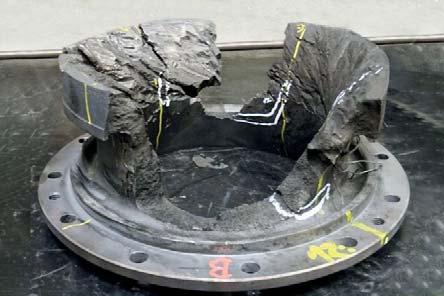
The researchers conclude that making use of the validated models meant that unwanted loops late in the project were avoided. “There is a clear need for this huge high cycle fatigue evaluation effort, as modern turbocharger impellers are extremely highly loaded, while nevertheless a safe operation of the series product has to be guaranteed.”

Frame sizes
The TCP and TCF turbocharger series both consist of seven frame sizes, including the introduction of a new TCP/ TCF 19 size. The modular design of the turbochargers ensures that compressor and turbine sizings are suitable for various engine needs.
All TCP frame sizes can be operated at pressure ratios clearly about 6, says PBST, tending towards 6.6 for larger frame sizes. The wide TCP compressor map achieved means that, in comparison to the TCR-42, the charge air pressure can be increased by over 1 bar.
According to the PBST researchers, the TCP is a compact single-stage turbocharger series with a pressure ratio and efficiency level far beyond current single-stage turbochargers. It is a well-balanced compromise between operating cost, compactness and CAPEX.
For engine outputs from 800 to 5,800 kW per turbocharger, a maximum pressure ratio of up to 7.0 is possible. The turbocharger increases engine power density up to 20% and reduces specific engine costs up to 20%. It is designed for “plug and play” using the same connection dimensions as similar previous turbochargers, and its features are suitable for future fuel readiness.
For outputs from 1,000 to 7,200 kW per turbocharger, the TCF series features an increase in specific flow of 20% and offers significant improvement in dynamic behaviour over earlier models, along with future fuel readiness. The series uses "wellknown" connection dimensions and is maintenance-friendly.
“The TCF series offers a very competitive charging solution for small 2-stroke engines with MAN B&W high-efficiency requirements. Further, the TCF enables the possibility to downsize the turbocharger on 4-stroke medium-speed engines.”
Test schedule
The numerical design process for the new turbochargers began in 2019, and the first TCP16 prototype has been undergoing testing since mid-2022. On-engine prototype tests are scheduled. A TCF technology carrier is undergoing testing this year, and validation of a first prototype will start in 2024.
PBST attributes the success of the development process to the company’s holistic design strategy which included customer-centred frame sizes and product safety concepts from the beginning.
TURBOCHARGERS For the latest news and analysis go to www.motorship.com JULY/AUGUST 2023 | 19
‘‘
The TCF series offers a very competitive charging solution for small 2-stroke engines with MAN B&W highefficiency requirements. Further, the TCF enables the possibility to downsize the turbocharger on 4-stroke medium-speed engines
FUELS TO DRIVE COMPONENT CHANGES IN TURBO DESIGNS
At CIMAC 2023, Raphael Ryser, R&D principal engineer at Accelleron, discussed what changes customers can expect to be made to turbochargers for large engines operating on new fuels

Together with researchers Hervé Martin, head of advanced technology development, and Dirk Bergmann, chief technology officer, Marcel Joho and Peter Sälzle, he highlighted that there are two areas to consider: the matching of the turbocharger and its components to the requirements of the engine and the compatibility of the currently used engineering materials with the fuel and its combustion products.
Ammonia, methanol, and hydrogen are the most promising zero/net-zero GHG emission fuels for large engines, says Ryser, and currently there is no technology in sight which can replace large engines in short- and mid-term.
The properties of new fuels vary, with the ignition and combustion properties of ammonia and hydrogen, for example, being significantly different from existing fossil fuels and methanol. Ammonia needs a lot of energy to ignite and burns slowly, whereas hydrogen is easily ignited and burns very rapidly. It has a very high laminar flame speed compared to other fuels. Ammonia also requires a very low excess air rate.
Both fuels, therefore, require specific combustion concepts that will impact turbocharger design. “The conclusion on this is that the combustion concept defines the required amount of air and not the fuel as such. The turbocharger therefore needs to be designed around the combustion concept,” says Ryser. “When you consider the chemically required minimum amount of air to burn fuel with a specific amount of energy (i.e. the energy required to attain the engine power), however, it is almost identical for all considered fuels. In reality, you don’t burn fuels at their required minimum amount of air (stoichiometric combustion) anyway.”
The changes required for the properties of the different fuels are not significant enough to change basic turbocharger designs. Mechanical limits will need to be met, but fuelspecific adaptations may only be necessary on the level of component layout, says Ryser. These will include consideration of stage loading and flow along with rotor dimension, the tip speed of blades and specific volume flow.
Accelleron has conducted several studies on different fuels, combustion concepts and applications. As the engines themselves are still in a relatively early stage of development, there is little information available that can be used for the specific changes needed for turbocharger component design.
Sensitivity studies have shown that especially in the case of ammonia, the switch of the fuel from diesel fuel or methane has the larger impact on the turbocharging requirements than the investigated level of uncertainty from engine tuning parameters and combustion characteristics.
For example, for Otto cycle engines, turbine area is likely to be needed to increase by 70% to ensure higher density at the turbine inlet. The higher air demand, if ammonia burnt at a very low rate and therefore deteriorated the thermal efficiency, would add another 20% to turbine area.
Dual-fuel applications are expected to be important due to the limited availability of sustainable fuel, but only some relatively simple control adaptions will be required for the
turbocharging system for these engines. This includes the inclusion of an engine bypass for ammonia combustion mode to ensure a suitable match with diesel operating lines.
There are some material considerations associated with new fuels. Certain turbocharger materials are exposed to exhaust gases, some also to small amounts of fuel. Depending on the fuel and the composition of the exhaust gas, there might be incompatibilities with certain materials, but at the current stage of engine development this cannot yet be confirmed or excluded, says Ryser. “While both methanol and ammonia tend to attack currently applied sealing materials, methanol may harm certain materials with certain combustion concepts and ammonia may be corrosive to bearing parts. For hydrogen on the other hand embrittlement is an often-discussed risk, but the current level of knowledge does not indicate that any serious issues should be expected.”
Lubricating oil must be adapted to keep its function for methanol and hydrogen. Methanol potentially forms an emulsion with the oil, and hydrogen creates the risk of coking. However, ammonia is not expected to react with lubricating oils, although it could lead to a corrosion risk for turbocharger bearings. If ammonia can be released from the oil or be neutralized this risk does not exist, says Ryser.
He concludes that there will be a relatively small impact on the basic layout of turbochargers. Ammonia and hydrogen have significantly different properties to hydrocarbons, and the low excess air ratio for ammonia in Otto cycle requires a large turbine and small compressor maps. Engine bypass is a simple solution for the accommodation of the operating lines in the compressor map.
TURBOCHARGERS 20 | JULY/AUGUST 2023 For the latest news and analysis go to www.motorship.com
8 Raphael Ryser
ENERGY SAVER

becker products

The energy-saving Becker Twisted Fin is suitable both for newbuildings and retrofits. It significantly reduces SOX, NOX and CO2 emissions and saves energy by 3% on average – even more when combined with a Becker

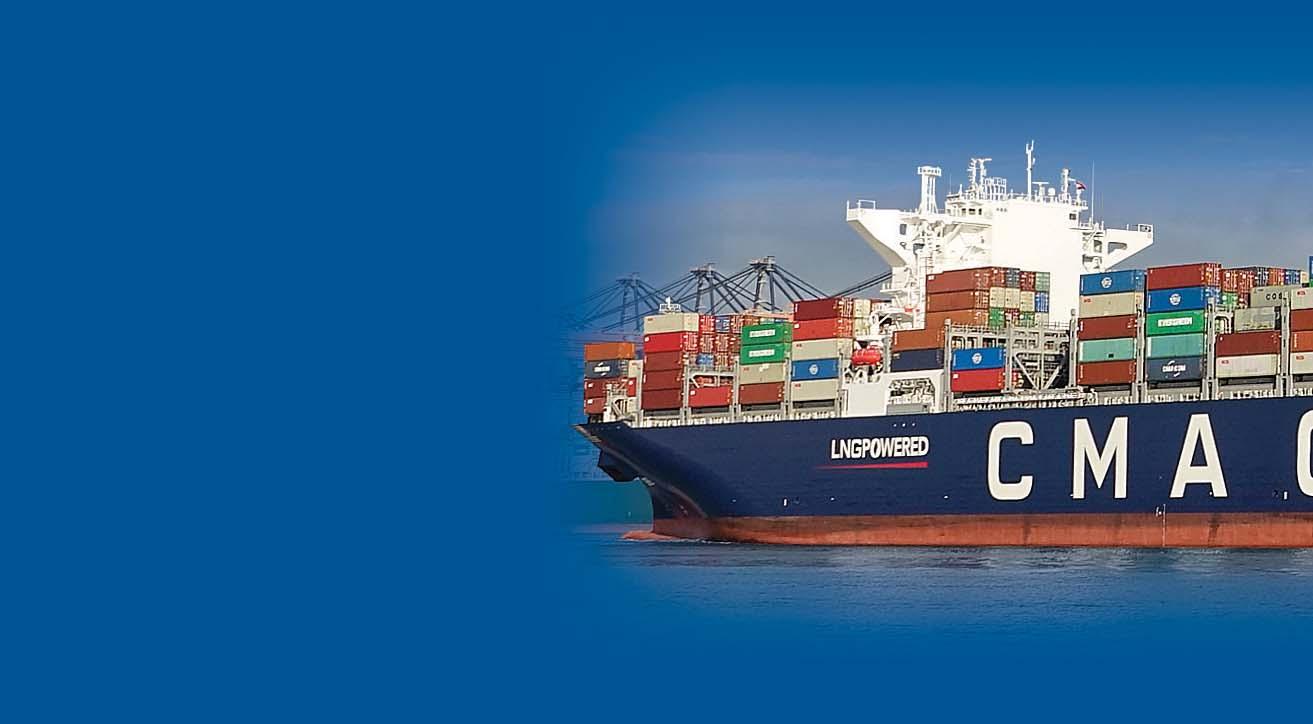
www.becker-marine-systems.com
t Pict Pic e ure u e © Ke es T e n orn
Manoeeuvring Systemms Energy-Saving Devices
Right: 14,800 TEU Container Vessel CMA CGM Tenere Owner: CMA CGM Becker Twisted Fin
e nvironmentally friend l y
Rudder.
Powering shipping’s emissions-cutting ambitions
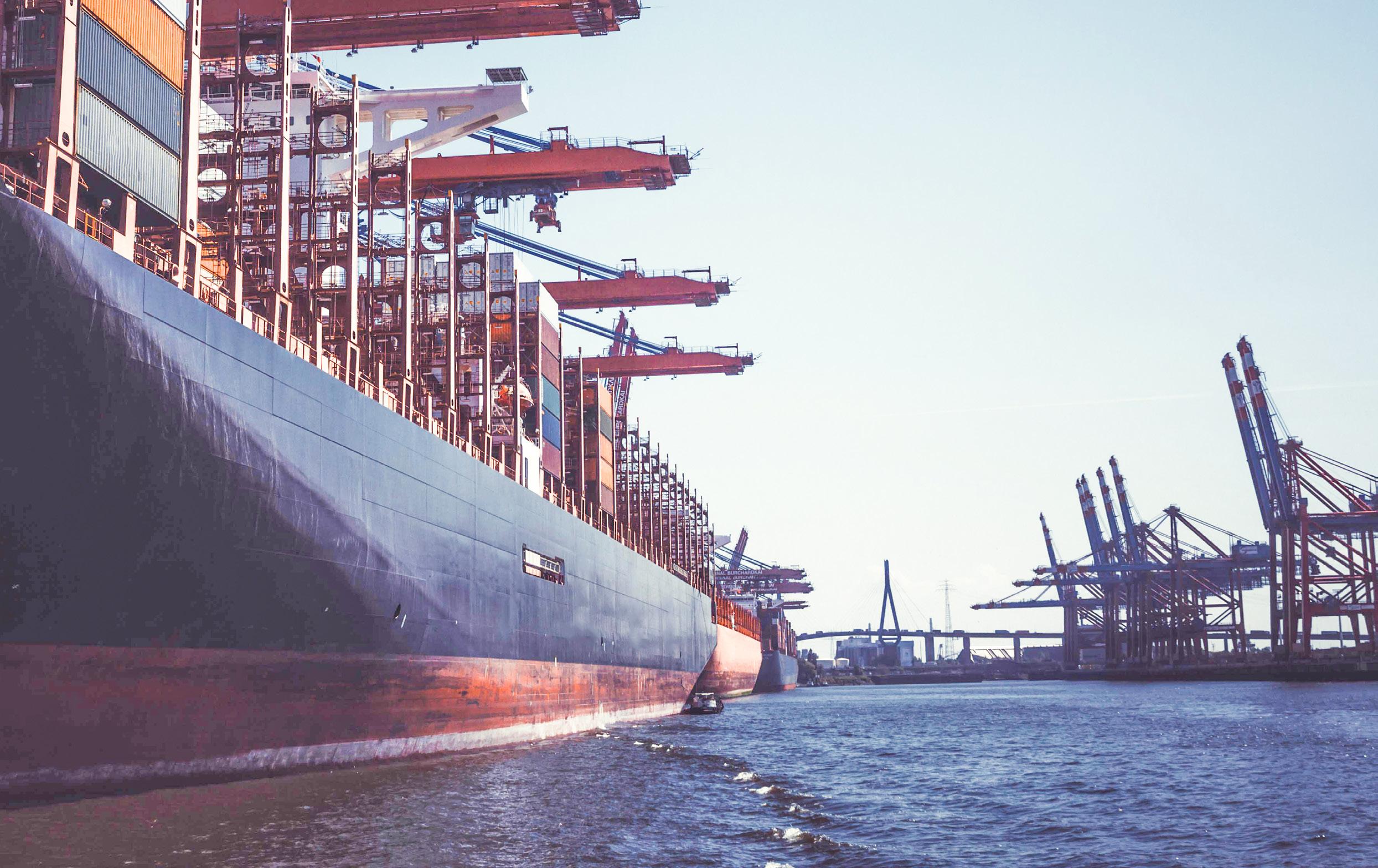
Propulsion stream | Alternative fuels stream | Technical visit









Two days of conference streams commencing with a keynote panel focused on the cost of financing decarbonisation and who is going to pay, followed by sessions that will explore the Fuels for 2030, Safety challenges with new technology and the shortlisted nominations for the Motorship Awards. Within the streamed sessions on day 2 you can expect to learn about the specific challenges with LNG / bio methane, ammonia, methanol, liquefied hydrogen, retrofit solutions, advances in lubrications, and carbon capture.
Chairmen: Lars Robert Pedersen, Deputy Secretary General, BIMCO

Markus Münz, Managing Director, VDMA Large Engines


Sponsored by:
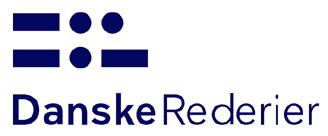




Supported by:

visit: propulsionconference.com

contact: +44 1329 825335

email: conferences@propulsionconference.com
THE Media partner: Media supporters:
Empire Riverside Hotel, Hamburg Conference Programme
#MotorshipPFF 23 TO NOV 202 3 21 Hamburg Germany 2023 44TH MOTORSHIP MARINE TECHNOLOGY
DAY ONE - TUESDAY 21 NOVEMBER 2023
08:00 Coffee & Registration
09:00 Chairmen’s welcome
Lars Robert Pedersen, Deputy Secretary General, BIMCO
KEYNOTE PANEL: THE COST OF DECARBONISATION & WHO IS GOING TO PAY?
Moderator: Lars Robert Pedersen, Deputy Secretary General, BIMCO
Annika Kroon, Head of Unit D1 Maritime, Transports & Logistics, European Commission
Simon Bennett, Deputy Secretary General, International Chamber of Shipping
Martin Kröger, CEO, VDR (German Shipowners’ Association)
Markus Münz, Managing Director, VDMA Large Engines
Wolfram Guntermann, Director Regulatory Affairs, Hapag-Lloyd AG
10:30-10:50 Coffee and Networking
SESSION 1 THE SOLUTIONS FOR 2030
Moderator: Sebastian Ebbing, Technical Advisor, German Shipowners’ Association
10:50-11:50 Reaching 2030: the continuous marathon of change – regulatory, technological and financial challenges.
Antony Vourdachas, Principal Engineer, Global Sustainability, ABS
Whether it is the IMO CII, EU ETS or FuelEU, Ship Operators are facing major challenges adapting to the new regulatory landscape. Multiple ship types and operational profiles require different approaches to reaching the mid-term 2030 goals and one solution does not fit all.
Taking efficiency to the next level for large cargo vessels
Oskar Levander, SVP Business Development, Business Development, Kongsberg Maritime Finland OY
Breaking new ground for efficiency in the marine industry
Janne Pohjalainen, Global Product Line Manager, Marine Propulsion, ABB Marine & Ports
Maritime Energy Transition to 2050
Rasmus Stute - Area Manager, DNV Maritime
Gain the latest insights from DNV’s Energy Transition Outlook to 2050. How will the maritime industry respond to the decarbonisation challenge? What will the maritime fuel mix look like in the years to come?
11:50-12:10 Q&A
12:10-13:40 Lunch & Networking
SESSION 2: SAFETY CHALLENGES FOR NEW TECHNOLOGY
Moderator: Lars Robert Pedersen, Deputy Secretary General, BIMCO
13:40-14:40
Enabling sustainable scalable fuel pathways – with a focus on Ammonia
Claus Winter Graugaard, Head of Onboard Vessel Solutions, Mærsk Mc-Kinney Møller Center for Zero Carbon Shipping
Optimizing the lubricant supply towards 2030
Serge Dal Farra, Global Marketing Manager, Total Lubmarine
The operation challenges that ship operators face grow daily with increasing scrutiny on decarbonization efforts. How engines are lubricated is a critical piece of this puzzle. We are actively developing new ways to make our customers’ lives easier. We are doing this by using the benefits of better ship connectivity, using quality operational and performance data, improving engine monitoring and lubrication planning, and using digital ordering to maximize uptime and delivery efficiencies.
New Technology & Safety
Brent Perry, CEO, Shift Clean Energy
Using a pay-as-you-go subscription model for electrification, swappable batteries create a viable solution for maritime decarbonization. With a commercial subscription model, customers pay or energy used per trip, eliminating typical barriers of electrification such as capex, charging infrastructure, and battery maintenance.
Exploring the integration challenges in the maritime Gisle Anderssen, VP Sales and Marketing, Vard Electro
Integrating power systems with alternative fuels to achieve optimal energy efficiency for sustainable operations.
14:40-15:00 Q&A
15:00-15:30 Coffee and Networking
Book online at motorship.com/PFFBOOK or fax form to +44 1329 550192 For further information please call +44 1329 825335 or email conferences@propulsionconference.com Book online at motorship.com/PFFBOOK or fax form to +44 1329 550192
SESSION 3: THE MOTORSHIP AWARDS
15:30-17:00
•WinGD Variable Compression Ratio (VCR) solution for X-DF engines - Dominik Schneiter, Vice President R&D, WinGD
•Wärtsilä - Ultra low emission gas engine technology - Diego Delneri, General Manager, Systems & product performance
•ABB - Technical aspects of ABB Dynafin™ propulsion concept - Janne Pohjalainen, Global Product Line Manager, Marine Propulsion, ABB Marine & Ports
•Ship Operator/Wärtsilä - Fit4Power - Speaker(s) TBC
17:00 Conference wrap-up and close
18:30 Conference Dinner
DAY TWO - Wednesday 22 November 2023
08:30 Coffee & Registration
09:00-09:15 Recap of day 1 by Chairman
Lars Robert Pedersen, Deputy Secretary General, BIMCO
10:30-10:55 Coffee Break
SESSION 4: PANEL DISCUSSION: LNG BEYOND TRANSITION
Moderator Lars Robert Pedersen, Deputy Secretary General, BIMCO
09:15-10:15 New generation of LNG fuelled container vessels: what has been improved and what will come next?
Can Murtezaoğlu, Business Development Manager EMEAI, GTT
Tom Strang, SVP Maritime Affairs, Carnival Corporation & plc
Elvis Ettenhofer , Head of New Marine Solutions, Four Stroke Marine & License, MAN Energy Solutions
Charlotte Røjgaard, VeriFuel Global Business Director, Bureau Veritas VeriFuel*
10:15-10:55 Coffee & Networking
SESSION 5
10:55-12:15
SESSION 5.1 AMMONIA
Moderator: Lars Robert Pedersen, Deputy Secretary General, BIMCO
Ammonia as a Shipping Fuel: Project
AmmoniaMot and research into FourStroke Engines in Medium and High-Speed Applications
Alexander Feindt, Global Business Development Manager, Marine (Four-Stroke), MAN Energy Solutions SE Pathway to Zero Carbon Emissions – Ammonia as Fuel
Dieter Hilmes, Sales Manager, TGE Marine
Ammonia will be one of the most important fuels for driving forward the decarbonisation of shipping. Dieter will highlight the opportunities and challenges that this new maritime fuel will bring.
SESSION 5.2 METHANOL
Moderator: Markus Münz, Managing Director, VDMA Large Engines
This session will be looking at the specific challenges and opportunities for methanol.
Presentation Title TBC
Greg Dolan, Chief Executive Officer, Methanol Institute
Decarbonizing global shipping: The practical steps to leveraging green methanol’s potential Barend Van Schalkwyk, Business Development Director, OCI
Green methanol is a crucial alternative fuel for the maritime sector to reach its decarbonization targets and the leading choice for the industry today. Drawing on OCI’s position as the world’s largest green methanol producer through its OCI HyFuels brand, Barend will share recent experiences supplying and bunkering the world’s first green methanol powered container ship and highlight what more needs to be done.
Book online at motorship.com/PFFBOOK or fax form to +44 1329 550192 For further information please call +44 1329 825335 or email conferences@propulsionconference.com Book online at motorship.com/PFFBOOK or fax form to +44 1329 550192
SESSION 5 (CONT)
SESSION 5.1 AMMONIA
Bringing ammonia two-stroke engines to the marine market
Dominik Schneiter, Vice President R&D, WinGD Reliability and Robustness in Ammonia fuel supply systems
Konstantinos Fakiolas, Naval Architect & Marine Engineer, MSc Marine Technology & Ship Science, MBA, Business Development Manager, Marine Market segment, Nikkiso Clean Energy and Industrial Gases
11.55-12.15 Q&A
12:15-13:45 Lunch & Networking
SESSION 6
13:45-15:05
SESSION 6.1 HYDROGEN
Moderator: Lars Robert Pedersen, Deputy Secretary General, BIMCO
New Rules – Handling Liquid Hydrogen Safely
Rolf Stiefel, Country Chief Executive, Bureau Veritas
Marine & Offshore for Central Europe
Hydrogen is both explosive and highly flammable, and it is vital that the right safeguards are in place to ensure its safe storage and use on board. New BV Rules on hydrogen will provide the industry with guidelines that keep seafarers and vessels safe.
Michael North, Sales and Marketing Manager, Lloyd’s Register*
Kim Strate Kiegstad, Vice President Sales, Corvus Energy*
Containerized marine fuel cell system
Sami Kanerva, Global Product Manager, Fuel Cells Marine Systems, ABB
Containerized marine fuel cell system comprises type approved fuel cell modules, internal piping, required auxiliaries and safety systems. Designed for above-deck installation, it provides a feasible solution to decrease the carbon intensity of existing vessels under stringent emission control requirements.
14.45-15.05 Q&A
15:05-15:35 Coffee Break
SESSION 5.2 METHANOL
SESSION 6.2 CARBON CAPTURE
Moderator: Sebastian Ebbing, Technical Advisor, VDR, German Shipowners’ Association
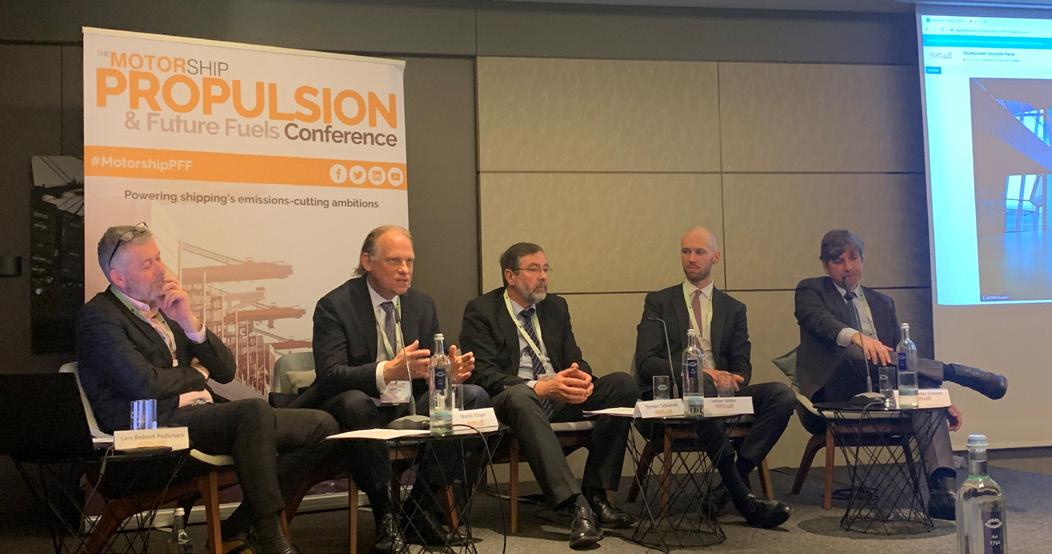
Will Pre-Combustion Carbon Capture Systems Applied to LNG Carriers and Containerships be an Option to Reduce CO2 emissions?
René Sejer Laursen, Director, Fuels & Technology, ABS Regulatory issues
Sebastian Ebbing, Technical Advisor, German Shipowners’ Association
Alfa Laval Mid Europe*
Knutson NYK*
Port of Hamburg*
14.45-15.05
Book online at motorship.com/PFFBOOK or fax form to +44 1329 550192 For further information please call +44 1329 825335 or email conferences@propulsionconference.com Book online at motorship.com/PFFBOOK or fax form to +44 1329 550192
Q&A
11.55-12.15 Q&A
SESSION 7
15:35-16.55
SESSION 7.1 RETROFIT
Moderator: Lars Robert Pedersen, Deputy Secretary General, BIMCO
Achieving EEXI and CII compliance with energy efficiency technologies:
Alessandro Castagna, Sales Manager / Naval Architect, Sales Department, Becker Marine Systems GmbH
The installation of propulsion improving energy efficiency devices (ESD) is proven to be one of the most suitable solutions in terms of cost and efficiency gain. ESDs like the Becker Mewis Duct® and Becker Twisted Fin® have a direct impact on the calculation of the EEXI (increase of Vref) and CII (reduction of fuel consumption and consequently CO2 emissions), improving the rating and helping shipping companies to reach compliance and to stay operationally competitive.
Presentation Title TBC
Klaus Rasmussen, Head of Projects and PVU SalesMAN PrimeServ, MAN Energy Solutions
Presentation Title TBC
Stam Achillas – Head of Business Development & Sales –2 Stroke Fuel Conversions, Wartsila
Simone Bernasconi - Head of Global Product Line Upgrades, Accelleron
SESSION 7.2 ADVANCES IN LUBRICATION
Moderator: Markus Münz, Managing Director, VDMA Large Engines

Lubricating the decarbonisation transition
Cassandra Higham, Marketing Director, Castrol Global Marine & Energy
The emerging expanded fuel mix poses new opportunities and risks, meaning the role of lubricants and lubricant providers within this sustainability-driven market is evolving. Castrol supports customers in smoothly navigating the everchanging market with digital and human technical expertise.
Advancements in cylinder lubrication for two stroke engines
Nikolaj Kristensen, Head of R&D, Hans Jense
Lubricators Advancements in cylinder liner lubrication technology have led to the development of spray lubrication systems, which offer increased flexibility as a means for reducing consumption, improving engine durability, and preparing for green fuels.
Sterntubeless vessels with water lubricated bearings – a novel promising design concept
Chris Leontopoulos, Director, Global Ship Systems Center, ABS
ABS granted “Approval In Principle” to the Shanghai Merchant Ship Design and Research Institute, SDARI, for a revolutionary vessel design that negates the risk of pollution from oil-lubricated bearing seals and promotes efficient vessel operations. The design, also developed in cooperation with Thordon Bearings, Canada, and the National Technical University of Athens, involves elimination of the sterntube, utilizing seawater for bearing lubrication, and creating an aft chamber to permit in-water maintenance, thus eliminating the need for drydocking or shaft line removal to replace the bearing and/or the seal. This promises significant efficiencies and substantial cost savings for most vessel types.
Assessing Lubrication environmental footprint
Lubmarine Market Liaison & Product Manager, Stuart Fuller
With shipping’s decarbonization journey well under way, Lubmarine Market Liaison & Product Manager, Stuart Fuller, shares key insights on the multiple approaches to reduce fuel consumption on 4S engines. As levels of activity increasingly focus on sustainable operations, the environmental impact of onboard lubrication is also a critical part of how operators transition to a cleaner future today and tomorrow.
16.35-16.55 Q&A
16:55-17:10
Conference Wrap up with Moderators and Chairmen
Lars Robert Pedersen, Deputy Secretary General, BIMCO
Sebastian Ebbing, Technical Advisor, German Shipowners’ Association
Markus Münz, Managing Director, VDMA Large Engines
17:10 Conference Close DAY
Book online at motorship.com/PFFBOOK or fax form to +44 1329 550192 For further information please call +44 1329 825335 or email conferences@propulsionconference.com Book online at motorship.com/PFFBOOK or fax form to +44 1329 550192
THREE
THURSDAY 23 NOVEMBER 2023
-
- TECHNICAL VISIT
*Invited
16.35-16.55 Q&A
Conference Fee
Cost per delegate Premium rate: €2475/ £2,100
Premium fee includes:
• Conference Attendance with lunch and refreshments on both days
• Full documentation in electronic format
• Place at drinks reception (21 November)
• Place at conference dinner (21 November) Place at technical visit (23 November)
Cost per delegate Standard rate: €2,380/ £2,000
Group booking discounts available
Special rate available for recognised educational establishments & ship operators
Please contact us for details
Booking Online propulsionconference.com or complete and fax the booking form below to +44 1329 550192. On receipt of your registration, you will be sent
Contact Us
For further information on exhibiting, sponsoring, or attending the conference, contact the Events team on: +44 1329 825335 or conferences@propulsionconference.com
Venue
Empire Riverside Hotel Hamburg, Bernhard-Nocht-Straße 97, 20359 Hamburg, Germany Visit propulsionconference.com
BOOKING FORM
2023 44TH 23 TO NOV 202 3 21 Hamburg Germany
BOOK ONLINE OR COMPLETE THIS FORM AND FAX TO +44 1329 550192
(Please copy this form for additional delegates)
Please tick all that apply :
Please register me for the Propulsion and Future Fuels Conference 2023 . I will attend the following:
Conference Dinner (21st November 2023 ) - No additional cost
Technical Visit (23 November 2023) - No additional cost
Members of supporting associations will receive up to 50% off your delegate booking.
I am a member of
Family Name First Name Title Mr/Mrs/Ms/Dr/Other
HOW TO PAY *UK registered companies will be charged the standard rate UK VAT
Bank Transfer: Mercator Media Ltd, HSBC Bank plc, EURaccount, Sort Code: 40-12-76, Account number: 70235247
SWIFT/BIC8: HBUKGB4B BRANCH BIC11: HBUKGB41CM1 IBAN: GB35HBUK40127670235247
Prepayment is required in full for entry to the conference. Full terms & conditions are available at mercatormedia.com/our-business/terms-and-conditions
Credit/Debit Card: Complete the form with your card details
I have paid by bank transfer
Please fax form. Do not send by email as we cannot guarantee the security of card information.
Please charge my card (delete as appropriate) Mastercard/Visa/Amex
Card Number
Name on Card Expiry Date
Security Code
Credit Card Billing Address
Signature
SPACE AT THE CONFERENCE IS LIMITED – RESERVE YOUR PLACE TODAY!
https://www.mercatormedia.com/terms-conditions-1
Book online at motorship.com/PFFBOOK or fax form to +44
1329 550192 For further information please call +44 1329 825335 or email conferences@propulsionconference.com
Company
Country Telephone Fax Email Signature
Company VAT No.
Job Title
Company Address
time.
terms
Book online at propulsionconference.com or fax booking form to +44 1329 550192 Registered in England. Company Number 2427909. Mercator Media Ltd reserve the right to alter the timing, content or speeches of this conference at any
Full
& conditions are available at
(3 Numbers on the reverse/ AMEX 4 numbers on front)
Further information call +44 1329 825335 or email conferences@propulsionconference.com. Book online at propulsionconference.com
OPERATING RANGE FOR NH3 COMBUSTION CONCEPTS
Dr Nicole Wermuth, research leader in combustion and fuels at LEC GmbH, presented results of an ammonia diesel dual-fuel combustion concept test at CIMAC 2023 highlighting the wide operating range achieved
The research team evaluated ammonia substitution rates, performance and engine-out emissions as part of a broader program of tests also involving ammonia-hydrogen combustion. Tests were conducted on a high-speed 4-stroke single cylinder research engine. For the ammoniadiesel tests, a centrally mounted wide-range diesel injector was used in an open combustion chamber with early intake valve closing before bottom dead centre.
Key to the concept tests is to overcome ammonia’s low flame speed and high ignition energy needs which are challenging for existing dual-fuel engine concepts. Additionally, the risk of N2O emissions means that new exhaust gas catalyst technology may be required for SCR to be effective.
The combustion tests demonstrated a wide operating range (4-25 bar brake mean effective pressure). Diesel fractions needed to be kept at 20% or lower to achieve significant reductions of greenhouse gas emissions.
In the evaluation of ammonia -hydrogen combustion, the researchers used spark ignition and pre-combustion mixing. This research involved assessing performance and emissions at fixed engine speed at brake mean effective pressure of 25 bar. A second set of tests then involved varied engine loads with hydrogen content set at 15%.
Unlike the diesel tests, in this case the ignition delay time did not increase with lower load. Rather the combustion phasing was nearly constant. N2O emissions and ammonia slip showed little variation over the load range tested and were significantly lower than the ammonia-diesel combustion results. The researchers conclude this is likely due to the homogenous mixing of the hydrogen leading to faster and more complete ammonia combustion than could be
achieved by the diesel pilot injection. Additionally, the earlier combustion phasing and resulting lower exhaust gas temperature might have reduced N2O emissions.
The researchers suggest that port fuel injection of ammonia can help reduce scavenging losses during valve overlap and reduced crevice volumes can potentially reduce both ammonia slip and N2O emission levels.
Tsuneishi commits to Dual-Fuel
Tsuneishi Shipbuilding of Japan has taken an industry lead by making a strategic commitment to other than conventionallyfuelled merchant vessels within the next 12 years. The group has stated that its goal is to produce only dual-fuel powered ships by 2035, to complete a shift away from tonnage fitted with heavy fuel oil-based engines. The Tsuneishi group has expanded to encompass Mitsui E&S Shipbuilding, Niigata Shipbuilding & Repair, Yura Dock Co and Kanda Dockyard.
A pillar of recent and current R&D work is the development of methanol-fuelled vessels. An early result of these endeavours is a methanol-capable dual-fuel Kamsarmax bulk carrier, the first of its kind worldwide, which has already attracted a raft of
contracts. Since the announcement of the design at the beginning of 2023, Tsuneishi has secured orders for 13 of the dual-fuel Kamsarmax vessels. The contract list for the latest version was opened this year when two of the 81,200dwt vessels were booked for Mitsui & Co, followed by two for Lauritzen NextGen Shipping, with all four to be employed by Cargill Ocean Transportation.
The new Kamsarmax has main dimensions of 229m x 32.26m x 20.15m. Through the primary use of methanol fuel in combination with a revised hull form, the design offers a 15% reduction in CO2 relative to the standard Kamsarmax type, while the stern mounted fuel tank does not restrict cargo capacity. The fuel efficiency of the design coupled with the high-capacity of the methanol fuel
8 LEC expanded its research infrastructure at the Graz University of Technology campus to focus on the research of ammonia combustion in large-bore engines in 2022

tank ensure the requisite range for deep-sea bulk cargo transportation.
Tsuneishi’s portfolio now also includes a methanol dual-fuel, two-stroke powered Ultramax bulker of 65,700dwt, for which Tsuneishi has at least one contract is in hand. The group has laid plans for the development of dual-fuel methanol designs of what it describes as “medium-sized” bulk carriers and container ships in the near future.
Nowithstanding the current focus on methanol, consideration is also being given to other companion fuels in a dual-fuel powering setup. An illustration of this approach is the collaborative design work being undertaken by Tsuneishi and Mitsui E&S Shipbuilding with Mitsui OSK Lines(MOL) on an ammoniafuelled, mid-size LPG/ammonia carrier.
ALTERNATIVE FUELS 22 | JULY/AUGUST 2023 For the latest news and analysis go to www.motorship.com
PROJECT TARGETS FIRST MAN
4-STROKE MeOH RETROFIT
MAN Energy Solutions has launched a project to develop retrofit solutions for medium-speed marine engines. The ‘CliNeR-ECo’ project includes partners from industry and research institutes, and will run until the end of 2025

The ‘CliNeR-ECo’ project is receiving support from the German Federal Ministry for Economic Affairs and Climate Action (BMWK), and is due to run for three years from January 2023. The project partners include WTZ Roßlau and TU-Darmstadt.
CliNeR-ECo aims to develop concepts for diverse, medium-speed, marine engines that will enable the retrofitting of entire ship fleets at reasonable economic and technical costs. The project is focusing on the climateneutral fuel, methanol, which is produced from green hydrogen with the intention being that results should quickly spawn other developmental projects for series production. In this respect, MAN Energy Solutions is currently planning a first retrofit project based on an MAN 48/60 engine; the first retrofit of a fully functional test engine is scheduled to reach the testbed in 2024.
With these maritime retrofit technologies, ship owners will be offered solutions that enable their existing fleets to comply with future emission targets for greenhouse gases. These will be introduced by the International Maritime Organization (IMO) and the EU in increasingly stringent stages from 2025 onwards in order to ultimately realise climate-neutral maritime shipping.
Dr Alexander Knafl, Head of R&D Four-Stroke Engines at MAN Energy Solutions in Augsburg, said: “MAN Energy Solutions is pursuing this project in close alignment with its own strategy for developing sustainable technologies and welcomes the opportunity to work with external research partners. For us, the path to the decarbonisation of the maritime economy begins with the switch to climate-neutral fuels. In this context, methanol is an excellent candidate as it is climate-neutral when produced from green hydrogen.”
Christian Kunkel, Head of Combustion Development, R&D Four-Stroke Engines at MAN Energy Solutions, added: “Electrification of the maritime industry is only possible in niche segments but not in so-called ‘long-distance shipping’. Energy sources such as carbon-neutral methanol and ammonia will therefore play a prominent role in the maritime sector in the future. Methanol is an ideal fuel for converting engines on existing ships and methanol tanks can usually be integrated into existing ship designs without too much trouble, while engine conversion costs can be kept within reasonable limits. Thus, with climate-neutral methanol production, the climate effect of the maritime industry can be improved very quickly while dispensing with the need for newbuilding construction. This is a crucial point as ship lifespans can last several decades in some cases and newbuildings demand a lot of resources.”
Dr Christian Reiser, CEO of WTZ Roßlau gGmbH, said: “Together with our partners, we are pleased to launch this ambitious project for CO2 reduction in shipping. The development of a retrofit-capable, methanol-combustion process presents us with exciting challenges, which we will solve together in this strong alliance.”
Prof. Dr.-Ing. Christian Hasse, Head of the Department of Simulation of Reactive Thermo-Fluid Systems at TU Darmstadt, commented, “Carbon-neutral and carbon-free fuels play a prominent role in our current research with methanol as a fuel for retrofitting marine engines playing a special role. The investigation of mixtures is, scientifically, highly exciting and directly related to the technical solution we will eventually develop. Ultimately, we will gain new insights into the dynamics of flow, injection and their interaction with the combustion chamber walls by combining high-resolution simulations and optical measurement techniques. This transfer of basic research into practical application is a strength of engineering research.”
Project partner roles
WTZ Roßlau gGmbH is a specialist in the field of energy conversion and will use a medium-speed test engine to develop combustion-process strategies for the retrofit concepts. This will be done in close cooperation with MAN Energy Solutions and will also form the basis for defining requirements for exhaust-gas aftertreatment.
The Technical University of Darmstadt will use a flow bench to work out the fundamentals of methanol mixtures in engines at its ‘Reactive Flows and Measurement Technology’ and ‘Simulation of Reactive Thermo-Fluid Systems’ departments. Together with MAN Energy Solutions, it will also develop the CFD simulation models required for adapting the technology to different engine sizes.
MAN Energy Solutions will transfer the retrofit concepts developed to large-volume four-stroke engines and prepare commercial development and production.
ALTERNATIVE FUELS For the latest news and analysis go to www.motorship.com JULY/AUGUST 2023 | 23
8 WTZ Roßlau has specific expertise in conducting research into hydrogen vectors on its singlecylinder test engines
Credit: WTZ Roßlau
DNV PLANS TO LAUNCH VTI TO HELP INDUSTRY’S DECARB DRIVE
DNV has decided to launch a Recommended Practice (RP) offering that aims to produce a method to measure and evaluate the technical performance of ships and to address some of the shortcomings that have emerged with the Carbon Intensity Indicator (CII) index
The Background to the work is arises from the fact that CII is impacted by external factors such as weather conditions, speed instructions, and loading condition, often overshadowing the true technical performance and efficiency of ships. “In its RP DNV proposes a Vessel Technical Index (VTI) as a complementary measure, showcasing a ship’s technical performance relative to its initial state, thereby eliminating the influence of external operational factors,” DNV said in a statement on 31 May, when it launched the project.
The RP also includes a novel approach to assessing the relevant sources of uncertainty, which will enable the users to take informed decisions based on the VTI calculations.
Trond Hodne, Business Director Maritime at DNV, said in a statement that the RP would mainly focus on the technical condition of the ship, as this is the area over which owners have a direct influence. The VTI could be used for four principal purposes:
1) A standardised way of working with performance data and creating a baseline;
2) Facilitating dynamic- and performance-based charter party agreements;
3) Assessing the optimal timing for hull and propeller cleaning and quantifying its impact and
4) Evaluating and quantifying the effect of energy efficiency measures.
Hans Anton Tvete, Head of Maritime Research at DNV, said that the aim of the work is to produce a platform that would incentivise both the owner and the charterer of a ship to work towards the decarbonisation of the industry.
The starting point would be a third party verified performance baseline, which would focus 100% on the technical efficiency of the ship to be hired. “This is in contrast to traditional charter party agreements, where owners could be given conservative figures to avoid a default,” Tvete pointed out to The Motorship
Charter rate adjusted according to ship’s performance
The actual technical performance of a ship would be measured and monitored over time, and the time charter rate payable to the owner would be adjusted accordingly. The VTI would create a direct link between performance and rates, as underperformance could lead to lower rates and vice versa.
From the charterer’s point of view, this would mean a higher cost of transport, but would also incentivise improved Scope 3 emission outcomes. In addition, the gains for the charterer would include: a reduced overall fuel bill, which will also lower environmental emission costs (e.g. in connection with the EU’s emission trading system); and the chartering of ships with a broader speed profile, Tvete said.
The role of DNV would be that of an impartial third party who will make the assessment regarding the performance of the ship. “If the ship’s hull starts to suffer from the growth of
barnacles, this will reduce the performance of the vessel, which would encourage the owner to sort the problem out,” Tvete noted.
In case of CII, operational matters can significantly affect the rating of a ship and as a result, identical sister ships can receive widely different ratings if their operational profile differs markedly from each other. The model DNV is proposing would eliminate this risk and focus on the actual performance of the vessel against a benchmark.
The VTI approach proposed by DNV would reward ship owners for restricting biofouling, Hans Anton Tvete noted.
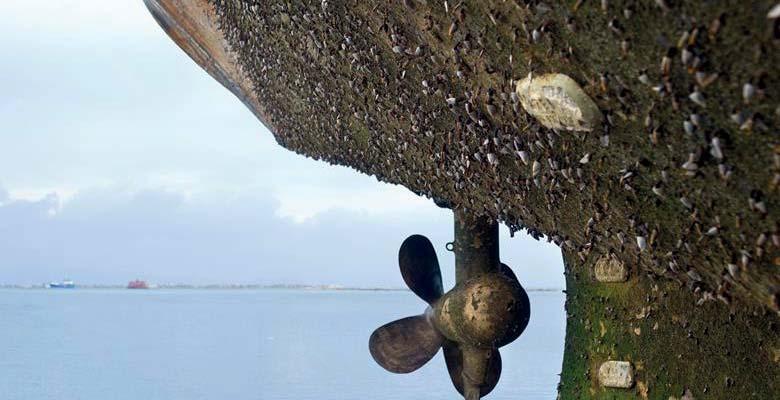
“It has not been so easy to measure these things before,” Tvete continued, adding that the quality, frequency and accuracy of the data required in the proposed model are its backbone. “It is also possible that a project like this can actually accelerate technical development,” he said.
The RP process will run until the end of August, after which all the input would be examined by DNV as the next stage of the work. The following step would be live trials of the system that should include a broad range of stakeholders, including manufacturers of fuel saving technology equipment. “You should also qualify the efficiency of fuel saving devices. Their business case will get better with the more expensive fuels in the future,” Tvete pointed out.
The data currently available regarding the efficiency of these devices may only include experience gained from certain weather and load conditions of the vessel, at certain speeds etc., so it is possible that the data does not cover all operating conditions that a ship can encounter.
After the pilot stage, the VTI would be launched for commercial use. However, it would also evolve over time as more data and experience becomes available.
“Regulations and other stakeholders such as cargo owners and financial institutions will increasingly put pressure on shipping to decarbonize. Reducing emissions and substantiating these efforts will become essential in a commercial setting where improved technical performance is likely to become a precondition for shipowners to gain access to capital and cargo,” Hodne pointed out.
EMISSIONS
24 | JULY/AUGUST 2023 For the latest news and analysis go to www.motorship.com
8 The VTI approach proposed by DNV would reward ship owners for restricting biofouling, Hans Anton Tvete noted
ABATEMENT
THE NEW KLONDIKE
Regulations need to be in place before prospectors start mining the seabed, writes Patrik
Wheater
The extraction of minerals from the seabed is gaining increased attention globally, most recently with the announcement in June that the Norwegian government plans to allow the mining of its continental shelf for “crucial metals for the global energy transition”. But regulation, rules, and standards are needed before prospectors start rushing to this new “Klondike”.
While mining the ocean floor at water depths of between 1000m and 6000m will undoubtedly benefit from offshore oil and gas industry experience, the recent tragedy surrounding the Titan submersible serves only to remind us of the dangers involved in navigating the deep. And although subsea mining vessels will be unmanned, there is still a risk of equipment loss, pollution, and accidents aboard the surface vessel.
Jonathan Struwe, Inspection Engineer and Surveyor, Underwater Technology, at Norway-headquartered classification society DNV, which is assisting the International Seabed Authority in the development of guidelines, said the technology required for subsea mining at these depths needs to be certified for safety and environmental reasons.
He said that while it is unlikely these unmanned subsea mining machines will need to carry out complicated tasks, they will be high voltage, requiring a huge amount of power and a lot of interaction with the human interface. “In theory, this means there are requirements for certification but there is currently no international regulation in place.”
According to DNV’s Chief Specialist, Environment, Jens Laugesen, one of the main technical challenges is getting the mined minerals and metals from the seabed to the surface. “I think one of the most difficult tasks will be pumping it up through a riser up to 6km from the seabed to the surface. The development of mining equipment is relatively possible, it will need to withstand higher pressures; but the riser and getting it up is a tricky part,” he said, adding that a pilot test last year saw 3000 tonnes of nodules brought up through a 4300m riser to a surface vessel.
That surface vessel was Hidden Gem, a 228m long ultradeepwater drill ship previously called Vitoria 10000, which Allseas converted to a polymetallic nodule collection vessel in 2021. In November that year, The Metals Company and Allseas successfully trialled their jointly developed deep-sea mineral collection system to responsibly recover polymetallic nodules from the ocean floor and transfer them to a surface vessel for transportation to shore.
The Metals Company is currently undertaking the world’s largest integrated ocean surface-to-seabed research programme to fully understand the impact of collecting nodules from the ocean floor.
Laugesen believes that the first mining expeditions will see all finds and surplus materials being taken up from the seabed and shipped to shore since there is no vessel currently capable of de-watering the surfaced material and residual waste in such volumes.
While seabed mining holds promise for resource extraction, containing valuable metals such as silver, gold, copper, manganese, cobalt, zinc and other important elements, the primary concern is the potential disruption of fragile ecosystems and biodiversity.
Indeed, when DNVs research department in 2014 started
looking at the impacts of deep-sea mining in 2014 they quickly identified the environment as the most important consideration, subsequently publishing a recommended practice but “there is still a lack of information about life on the seabed, and what will happen down there if you start a [mining] operation,” said Laugesen.
For its part, the Norwegian government has stressed that extraction permits for national waters on the Norwegian continental shelf will only be given once environmental sustainability has been demonstrated, while recognising the economic potential seabed mineral activities offers as a nascent industry
Not everyone agrees. Some member states of the International Seabed Authority, namely Canada, France and Germany, want to slow development down due to the lack of hard environmental knowledge. And during its 27th session, ISA decided among others to progress the development of environmental threshold values as binding standards as part of the ongoing development of standards and guidelines that support the development of the draft regulations on the exploitation of mineral resources in international waters (defined as the Area).
Nevertheless, if seabed mining does increase – and there are currently about 30 subsea mining projects that have been granted exploration licences in international waters by ISA – there will be a need for constant and extensive monitoring of the seabed to ensure the environment is not adversely affected. (To date, no licences have been granted for exploitation.)
In 2021 ISA published Technical Study No. 29 concerning how remote monitoring technologies in addition to physical inspections can be used in the inspection regime for monitoring of all mining activities. The study, carried out by DNV, has been used by ISA in the ongoing work with the inspection regime that will be a part of the regulations for exploitation of seabed minerals.
The ISA council, which met in Kingston, Jamaica, in July had hoped to complete the adoption of the relevant rules and regulation within two years of a request for exploitation. The Metals Company submitted a request in June 2021, which has now expired.
8 Allseas completed a pilot test bringing up 3000 tonnes of nodules through a 4300m riser to a 228m long ultradeepwater drill ship, Hidden Gem, (pictured) in 2022

EMISSIONS ABATEMENT For the latest news and analysis go to www.motorship.com JULY/AUGUST 2023 | 25
Credit: Allseas
HOW LONG WILL COAL REMAIN A MAJOR TRADE?
Rumours of seaborne coal’s demise have been greatly exaggerated, to quote Mark Twain, but shipowners should eye proposed restrictions on new projects in Asia
While the commercial shipping sector has been focused on the IMO’s 2023 GHG Strategy discussions, and upcoming discussion of mid-term measures, it may have been distracted from environmental developments affecting important downstream markets, such as seaborne coal.

The Ukraine war has led to a limited revival in thermal coal consumption in Western Europe, but longer-term discussions involving the financial community revolving around definitions of emissions abatement appear to be introducing a deadline for the closure of existing power generation capacity.
Singapore is currently finalising a Singapore Asia Taxonomy, which is likely to require existing thermal coal capacity to close by 2040 at the latest. Much of the discussion revolves around definitions of abatement, as proponents of net zero technologies (such as carbon capture or ammonia injection) endeavour to include these solutions among acceptable options. The current discussions focus on measures to accelerate the closure of existing capacity, which poses significant challenges for southeast Asian and south Asian economies struggling to increase power supply to meet growing demand.
Ammonia abatement
Japanese researchers have been active developing solutions to permit supercritical coal plants to reduce their CO2 emissions by co-firing with ammonia. A 2019 study by IHI Corporation found that in some cases, an injection of 20% ammonia into coal boilers could also reduce their output of nitrous oxide (NOx), a gas orders of magnitude greater potential for trapping greenhouse heat than CO2.
IHI expects that coal co-firing with green ammonia could reduce carbon emissions, enough to bring those from an ultrasupercritical coal powerplant down to 636g-CO2/kWh – below the level of an oil-fired plant – and would provide a cheap way of cutting emissions without completely rebuilding infrastructure, or increasing Japan’s reliance on nuclear power.
But leaving aside the vexed issue of accessing funding to permit such retrofits, there are reasons to believe that countries may not want to do this. In the US, research by Energy Innovation discovered that in 72% of cases, just continuing to run existing coal powerplants would be more expensive than building and running new renewable energy from scratch. That analysis, conducted before the Inflation Reduction Act passed in 2022, was later updated to 99%, after the Act provided $370bn in tax credits and other inducements for renewable energy.
Crucially, the study made no mention of carbon capture utilisation and storage (CCUS), which is being touted as coal’s Hail Mary. Since 2009, the US Department of Energy has invested some $684m in CCUS projects at 8 coal-fired powerplants, only to find that seven of the projects were never built when their operators could not make the economics stack up.
A further one, Petra Nova, situated at the W A Parish Generating Station, was shut down in 2020, soon after it was built, citing prohibitive operating costs. By this time, it had accrued a total capex cost after private investment of over $1bn, in exchange for a maximum CO2 abatement of 4%.
In general, CCUS is expected to add millions of dollars in running costs to beleaguered powerplants, meaning that in
CARBON
26 | JULY/AUGUST 2023 For the latest news and analysis go to www.motorship.com
8 Japanese ship owners have invested in modern fleets of specialist coal carriers, such as K Line’s Corona Youthful
CAPTURE
due course, not only will the balance tip even further against coal and in favour of new renewables. According to the latest studies from Bloomberg NEF, the global average levelised cost of energy (LCOE) for onshore wind and solar ranged between $42-$48/MWh, while even new windfarms offshore now carry a cost equivalent to coal, at $74/MWh, BNEF finds.
High on its own supply
The thermal coal has been volatile in recent months. At the height of combined pandemic and war supply chain disruptions, in September 2022, coal prices reached $439/ tonne, substantially more expensive even than crude oil prices had been in the early pandemic. Then, coal prices reached their lowest ebb since mid-2021. This prompted predictions by the World Bank that for the rest of 2023, both coal prices and coal demand will stay elevated over pre-pandemic levels, but “…are expected to decline in the medium term.”
However, longer term considerations are likely to play a greater role in the evolution of the seaborne thermal coal market than short term market fluctuations. China remains the single largest consumer of thermal coal in the world –accounting for around 53% of global consumption – while by opting to effectively ban imports of lower-cost Australian thermal coal until February 2023, it chose to prioritise higher cost domestic production and regional imports, including Russian imports from Vanino and other Russian Far East bulk ports.

Goodbulk wants to get off the ride. It shed ten capes in 2022, and ten more this year. “Capesize rates were volatile over the quarter, starting off at $13,561 per day on 23 January 2023 then falling to their lowest at $2,246 per day on 17 February 2023 before rebounding up to $13,806 per day at the end of March and continuing to increase to $19,283 per day on 4 May 2023,” Goodbulk’s Q1 results noted.
For the time being, demand for shipping coal to China is rebounding dramatically, even though domestic production is once again increasing. Surging imports from Mongolia have had an effect, while capesizes benefit from growing Chinese imports from Indonesia, and to a lesser extent Russia and Australia. The latter resumed exporting coal to China in early February.
These add up to an increased total coal supply in China of 15%, as of end June. “Despite China’s strategy of pursuing increased domestic coal production, which has meant that yearto-date production stands 5.8% higher than last year, its seaborne imports of coal have nevertheless surged 73% year on year so far,” said BIMCO chief shipping analyst Niels Rasmussen.
Norden is presumably feeling smug. It sold four bulkers at the top of the market in 2022, and in March, acquired six secondhand capesizes at knock-down prices which will arrive just in time to take advantage of this latest surge in China coal and iron ore imports. “During [Q1], we… captured significant profits from vessel sales, while widening our portfolio to cover all dry cargo segments with the purchase of Capesize vessels,” said CEO Jan Rindbo.
Yet if pre-pandemic trends are any guide, in July 2019, coal prices had more than halved year-on-year, to $50 per tonne. In fact, such was the spread between the price of coal and the cost of the fuel needed to transport it that shipowners were questioning the economics of these bulker trades even then. Now, the IMO is targeting (or perhaps it is suggesting, “national circumstances” permitting) that ships will need to switch to net-zero fuels – which shipowners will be lucky to source at double today’s prices.
At the end of June, CSSC Qingdao Beihai Shipbuilding held a naming ceremony for the first two -- in a series of ten -210,000dwt newcastlemaxes to be built for Belgian shipowner Compagnie Maritime Belge (CMB), which will be capable of running on ammonia. Based on the WinGD X72DF design, their engines will burn ammonia, allowing for voyages with zero funnel emissions – provided that WinGD’s engineers can find a way to avoid massive NOx emissions in the process.
The trade of last resort
But as exhibited by Goodbulk, the fundamental nature of dry bulk trades means that the line between profitability and loss is a razor’s edge, and unlike container ships, bulkers are almost never profitable enough to warrant investments in innovative technologies. Clarksons data finds the bulk carrier fleet not standing out as particularly prime stock for the total rejuvenation that will be necessary to use new zero-emission fuels: the average bulker is around 12 years old, the average capesize nearly ten. Norden paid $28m each for its 2012-built capesizes; compare with the now infamous case study of Hapag-Lloyd’s Brussels Express retrofit, which cost $35m.
Given the volatility in freight rates, and concerns about the long term future of the specialist coal carrier trade, there will be questions about how smaller ship owners and operators in the Asian market will be incentivised to improve the efficiency of their vessels?
Seaborne thermal coal trade
As the International Energy Agency’s benchmark Coal 2022 report noted, the Asia Pacific region is the most important thermal coal trading region, supplying 63% of seaborne thermal coal exports, and receiving 82% of all imports in 2021.
While the largest markets, China and India, have sizeable domestic coal mining industries and are investing in new coal-fired generation capacity, other import markets in Asia are halting new investments in power generation capacity from 2023 in Indonesia and over the longer term in Vietnam.
CARBON CAPTURE For the latest news and analysis go to www.motorship.com JULY/AUGUST 2023 | 27
8 Mitsubishi Heavy Industries has been active promoting ammonia cofiring at coal-fired thermal power plants in Latin America and in Asia
Despite China’s strategy of pursuing increased domestic coal production, which has meant that year-to-date production stands 5.8% higher than last year, its seaborne imports of coal have nevertheless surged 73% year on year so far
‘‘
CARBON PURITY WILL IMPACT ONBOARD CONTAINMENT
Different onboard CO2 capture technology types result in different levels of purity, and this will have a significant impact on containment systems, says Rupert Hare, CEO of design and engineering consultancy, Houlder
8 Houlder has extensive experience in containment systems, and recently completed a concept design for a liquid hydrogen carrier for Shell
Somewhat ironically, the shipping industry’s decarbonisation and progress towards the IMO’s 2030 and 2050 goals may be hindered by a shortage of high purity CO2 and compounded by a lack of transportation infrastructure. These barriers could significantly impact the ability to produce e-fuels at scale.

While liquid carbon dioxide (LCO2) has been transported by sea for almost half a century, there is now rapidly growing demand to move large volumes of CO2 over increased distances. Forecasts for growth in demand have been predicated on the growing network of sequestration routes for CO2 captured from industrial processes.
In addition to the infrastructure demand to send CO2 for sequestration there is now a growing demand for it to be used as feedstock for synthetic fuels such as e-methanol and e-methane (e-LNG). Both are seen by many as practical, lower-risk alternative marine fuels in comparison to e-ammonia and e-hydrogen. Satisfying the demand for these fuels will create significant additional demand for a commodity which is already in short supply.
Carbon capture on board presents an interesting opportunity for a closed system whereby CO2 captured onboard ships is offloaded for use in synthetic fuel production. If those on-board capture systems can deliver pure CO2 they could offer the vessel owner a strong revenue stream in addition to the benefits of close to zero CO2 emissions.
Supply chain challenges
Transporting large volumes of CO2 by sea presents significant challenges, and we need to have a fundamental rethink on the way we approach it. The small number of vessels currently operating in this area predominantly transport high
purity food grade CO2 over relatively short distances. We are entering a new era of CO2 transportation with a range of distances, end destinations and significantly a much more diverse range of sources of the cargo. Importantly, we need to recognise that as onboard carbon capture gains traction then almost every ocean-going ship type has the potential to become a CO2 carrier.
The challenges also extend to shoreside infrastructure development. Aside from the need to build an adequate shore side infrastructure to carry the cargo to and from the ship it is also essential that the Master can establish the nature of the cargo that is being loaded. This necessitates certification of the purity of the cargo preloading.
Purity considerations
There is no standard technology for carbon capture either on board or in shore based industrial processes. There are many different alternatives and the transport supply chain needs to be ready to cope with CO2 captured from all of them. Each of these technologies results in different purity levels for the CO2. Both sequestration and reuse of CO2 require high purity and as purifying CO2 carries with it a significant cost and energy penalty, it is likely that high purity CO2 will command a premium and that capture processes directly producing high purity CO2 will also present a stronger business case, particularly for on board capture.
The purity of CO2 will be dictated by the method of its capture, the source of the CO2 (for example, exhaust gases or an industrial or chemical process) and any post capture clean-up process. Impurities could include the presence of other species in the CO2 or may reflect the presence of water.
It’s important to note that this isn’t a percentage game. The
CARBON CAPTURE 28 | JULY/AUGUST 2023 For the latest news and analysis go to www.motorship.com
biggest impact on the challenge of transport and reuse or sequestration is the nature of the impurities rather than their quantity. The significance of the impurity may be on the potential for corrosion in the containment tanks or in the loading or unloading equipment – as seen with hydrogen sulphide, sulphur oxides and water – or it may increase safety hazards in case of an escape, e.g. carbon monoxide, sulphur and nitrogen oxides.
From the perspective of the onboard containment system, a range of other so-called non-condensable gases such as nitrogen, argon, hydrogen or methane affect the storage pressure necessary for the liquid at a given temperature. When it comes to sequestration even oxygen can only be tolerated at parts per million level in former oil and gas reservoirs, as its presence can result in biological activity that will build up to clog the injection well.
Containment Tank Pressure Choices
The liquefication processes and the necessary cleaning and drying of the CO2 for it to be stored safely as a liquid can remove a large part of the impurity content in the gas. However, the presence of the residual non-condensable impurities in a CO2 cargo on either a dedicated carrier or one which employs on board carbon capture will have a significant impact on the design of the containment and reliquification plant. The size of the impact will be dependent on the nature of the impurity. Ultimately, investments in onshore equipment to achieve high purity CO2 could affect the CAPEX and OPEX of shipping , the risks of transportation, and the costs of mitigating those risks.
In a worst-case scenario, impurities could result in an increase in design pressure and hence tank weight of over 30% or require a reduction in storage temperature that would increase risks of cargo freezing but which will certainly have an impact on the energy requirement in the whole process. These challenges are particularly significant for the lower pressure transport systems which offer cheaper tanks and larger revenue earning cargoes.
Given the range of potential impurities the obvious questions are whether the Master knows what cargo is being loaded, or if the owner knows what range of cargos the ship will be expected to carry during its life. If the vessel is designed for one route with one source of CO2 (for example a dedicated vessel in a single CCUS transportation chain) these are easier questions to answer, but they limit the lifetime flexibility of the vessel.
In any case, the costs of maintaining the cargo increase with transport distance. Whilst standardisation of the storage pressure used may seem attractive it may not be the right answer for all cargo and voyage profiles. A the very least there is a need for a certification scheme which will ensure
that the ship, the cargo and the ultimate destination are appropriately matched.
Houlder has seen a number of tenders for LCO2 carrier designs that fail to recognise the number of variables and rely on a repeat of previous designs for key areas such as cargo containment. This misconception could result in significant over-specification of storage tanks and reliquefication plants, requiring unnecessary CAPEX. There is also the potential of a baked-in OPEX problem resulting from significant and potentially unnecessary increases in nonrevenue earning cargo weight and energy consumption.
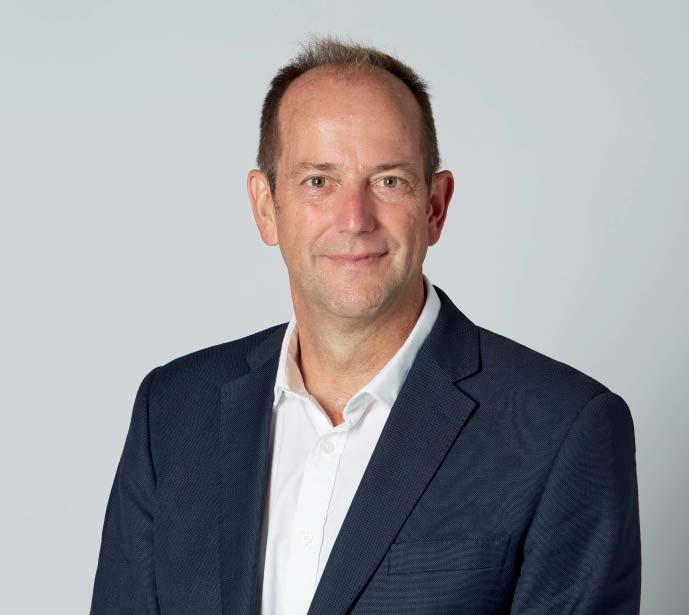
Specific regulation is required
The burgeoning CO2 industry faces new challenges and needs regulation designed to address them. It’s not enough to simply try to push the regulation of these cargoes into the same category as others .
There is no place for binary or blanket regulations. For example, the IMO has a correspondence group that has been discussing classifying LCO2 as toxic, putting it in the same category as ammonia. While CO2 has an asphyxiation risk, the harmful concentrations and consequences of exposure are different from those of ammonia. Regulators must not use blunt instruments when regulating sophisticated technical sectors. CO2 must either maintain its non-toxic classification or a new, more nuanced designation must specifically be developed.
As with all the challenges that we face in decarbonisation, it’s important to take a system-based approach and to balance opportunities and risks throughout that system. We have all been used to seeing ships as a system, but we can no longer look at the ship system in isolation. The transportation of CO2 presents a clear example of why we need to see the ship as part of the whole logistics and value chain and make sure it fits in the most effective way.
Delivering the supply chain for CCUS is an ambitious goal but we shouldn’t forget the other significant opportunities for the reuse of CO2 which will also require their own supply chains, To deliver this organisations such as ours need to look beyond the vessel and ensure that the marine transport is properly integrated into the whole supply chain.
CARBON CAPTURE
For the latest news and analysis go to www.motorship.com JULY/AUGUST 2023 | 29
8 Rupert Hare
‘‘
In a worst-case scenario, impurities could result in an increase in design pressure and hence tank weight of over 30% or require a reduction in storage temperature that would increase risks of cargo freezing but which will certainly have an impact on the energy requirement in the whole process
DIGITALISATION BREAKING DOWN SHIP-PORT DISCONNECT
There’s a potential flow of data from a ship’s propulsion system to the next port of call, and a growing number of companies are collaborating on making the most of it to reduce emissions
“It starts with a single asset, the vessel, and it builds from there,” says Osku Kälkäjä, Head of Digital Business at ABB Marine & Ports. “The vessels and shipowners are working globally, but the ports are working locally, so to put them together, that requires time and cooperation.”
There are a huge number of different variables that go into minimizing emissions, he says. These include when the vessel leaves port, manoeuvring, pilot boarding and transits that can sometimes vary due to commercial considerations from what was initially planned. However, digitalisation is important no matter what size a company is. “If you miss the train, you will get nowhere,” he says.

ABB and Wallenius Marine have developed OVERSEA – a fleet support centre available as a service. OVERSEA leverages ABB’s Ability™ Genix Industrial Analytics and AI suite, and combines it with fleet management knowledge from Wallenius Marine, to help ship operators decrease fuel consumption and reduced emissions. Its scope includes hull and machinery, speed and route planning, as well as emissions and carbon intensity reporting.
Data flow from the power and propulsion system is key to maintaining propulsion efficiency, and other collaborations build from there. For example, knowing the ETA early in the voyage allows a vessel to set the power applied to the main engine at the right constant level to achieve the time slot. Søren Andersen, Chief Executive Officer – StormGeo, says
that ships “rushing” to port and then subsequently waiting outside port (sometimes for days) is probably the largest addressable waste of CO2 in the shipping industry today. StormGeo is developing solutions that can improve the interface between port and ship to improve or achieve justin-time arrival.
Integrating port data into voyage optimisation
For example, the company has run a pilot on specific ports, proving that it can predict port closures due to weather and swell conditions with very high accuracy. “We are also developing ways to map port congestions with the same purpose. By making these predictions available to our shipping customers, they can better plan their voyages and take such events into account. The benefit of these initiatives is that we do not need many stakeholders to be involved in the work. A few data sources are sufficient to develop these solutions.
“The challenge we, as an industry, are looking at is complex, but there shouldn’t be any hard showstoppers. The ship would need to know as early as possible in its voyage (or even before the voyage starts) when it can berth at the next port for loading/offloading operations. For that, the port will need to plan ahead to assign (and adjust) its berth deployment and then communicate the plan for the vessel as early as possible.”
This is doable for container ports already but more
BATTERIES & ELECTRIFICATION 30 | JULY/AUGUST 2023 For the latest news and analysis go to www.motorship.com
8 The Port of Antwerp-Bruges has recently launched an extensive digital radar and camera network that scans the entire 120km2 Antwerp port area
challenging for bulk and tank terminals. “Here, we’re facing the challenge that also the cargo buyer and their financier may need to be involved. When the cargo is offloaded, the bill of lading changes hands, and the cargo is paid for. Therefore, the cargo buyer and financier would also need to be privy to the berthing plan. So, it is a bit complex but not at all impossible, and in StormGeo, we have a platform where the ship operator, port, cargo owners, and financiers can ‘meet’ and exchange necessary information.”
Pekka Pakkanen, Executive Vice President for Shipping Solutions at NAPA, Coordinator of the Blue Visby Consortium, says a surprisingly small amount of commercial data, in addition to AIS data that is already publicly available, is all that is required to make the Blue Visby platform work.
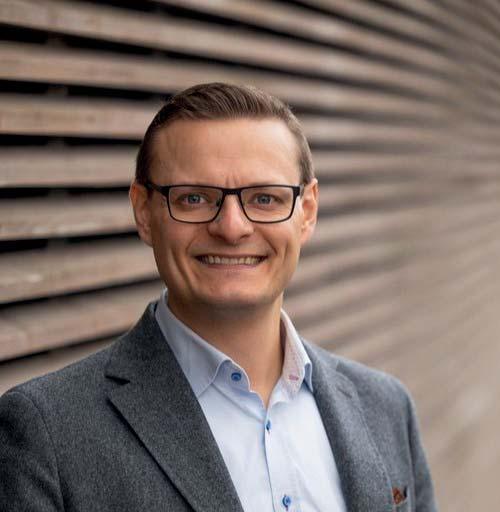
Coordinating arrivals
Blue Visby uses digital technology to create a dynamic queuing system that optimises and staggers arrivals times for groups of vessels travelling to the same port. The aim is to reduce unnecessary time spent in anchorage, while also enabling ships to slow down, cut their emissions, and arrive one after the other – all without losing a competitive advantage, as the algorithm maintains their order of arrival as if they had sailed independently without the solution.
As opposed to just-in-time arrivals, which require extensive coordination by ports, Blue Visby tackles the sail-fast-thenwait problem differently. It enables the different vessels to come together to reduce their emissions by optimising their arrivals, without requiring a complex alignment of stakeholders on the port side.
Blue Visby does not require ports to provide detailed information on berthing planning and is therefore scalable to all ports. Congestion levels that help inform recommended ETAs for participating vessels can generally be analysed from AIS data, although for some ports the platform may require data on the number of vessels queuing to specific terminals and possible priority of some ships, for example.
“The recommended ETAs provided by the software consider each vessel’s departure time, characteristics and performance given current weather conditions, as well as the levels of congestion and capacity at the port, and all the other vessels at berth, at anchorage or on their way to the port, regardless of whether or not they are participating in the Blue Visby solution,” says Pakkanen. “While a master’s report of departure time would be most accurate, publicly available AIS data is a reasonable substitute. Ship performance is evaluated using digital twins in a manner that is predictable and fair for all participants, and recommended arrival times are updated and refined throughout the journey as more detailed information becomes available.”
Another pillar of Blue Visby is a contractual framework that enables charterers, shipowners and cargo owners to share the costs, risk and rewards of participating in the project. This includes fuel savings, the costs of a lengthier journey, and the financial value of emissions reductions. For those benefitsharing calculations, the platform requires information about the stakeholders involved in a voyage and whether it is operated under a time charter or spot with a Notice of
Readiness tendered in anchor.
Every voyage is underpinned by a web of contracts, including charterparties, bills of lading and sales contracts, and a variety of terms on those contracts create split incentives. For example, charterparties often contain clauses on minimum speed warranties, an obligation to sail with utmost dispatch, requirements to arrive by a particular date, or penalties for late arrivals or sailing at slower speeds.
Blue Visby solves the split incentives problem by introducing a new contractual framework inspired by the principle of general average, says Pakkanen. Under the sharing mechanism, demurrage would be considered a loss and compensated to the shipowner. On the other hand, financial benefits such as the value from the fuel savings and CO2 reductions would be shared between the different parties.
Furthermore, Blue Visby creates a multilateral contract between the multitude of vessels that sail to the same destination. This is designed as a mutual association – the Blue Visby Mutual Association, which is inspired by mutual insurers (P&I Clubs). There are currently 28 companies in the Blue Visby Consortium, refining the solution and aiming to have the first real-life prototypes operational by the end of 2023.
Meanwhile, ports are introducing their own efficiencyboosting collaborations. While some ports are still using whiteboards or spreadsheets, others are already using AI to automate and optimise port, tug and pilotage operations, says David Yeo, Founder and CEO of Innovez One. These are complex operations with multiple moving parts, as pilots must be assigned to specific vessel types and sizes depending on their licence, tugboats must be in sufficient numbers for the job, and shuttles must be planned to take the pilots to the correct boarding grounds.
Machine learning, a subset of AI, can learn from historical data to predict the duration of each job based on factors such as the weather conditions, vessel type and the different jobs required. Using the predicted duration of all jobs, these technologies are able to deploy resources such as tug and
BATTERIES & ELECTRIFICATION For the latest news and analysis go to www.motorship.com JULY/AUGUST 2023 | 31
8 Osku Kälkäjä, Head of Digital Business at ABB Marine & Ports
‘‘
The vessels and shipowners are working globally, but the ports are working locally, so to put them together, that requires time and cooperation
SIGN UP TODAY
Seawork celebrates its 25th anniversary in 2024!

The 25th edition of Europe’s largest commercial marine and workboat exhibition, is a proven platform to build business networks.
Seawork delivers an international audience of visitors supported by our trusted partners.
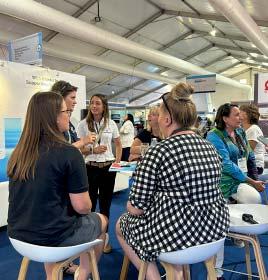
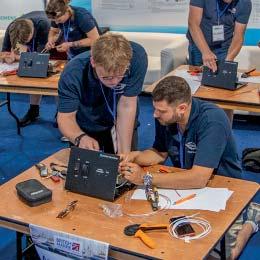

Seawork is the meeting place for the commercial marine and workboat sector.




12,000m2 of undercover halls feature 400 and equipment on the quayside and pontoons.
Speed@Seawork on Monday 10 June in vessels operating at high speed for security interventions and Search & Rescue.
For more information visit: seawork.com contact: +44 1329 825 335 or email: info@seawork.com
The European Commercial Marine Awards (ECMAs) ceremony celebrates individuals and innovative companies on Tuesday 11 June.
experts, helps visitors to keep up to date with the latest challenges and emerging opportunities.
The Careers & Training Day on Thursday 13 June 2024 delivers a programme focused on careers in the commercial marine industry.

JUNE Southampton United Kingdom 11 13 TO
#Seawork Media partners MARITIMEJOURNAL COMMERCIAL MARINE BUSINESS BOATINGBUSINESS THE UK LEISURE MARINE BUSINESS Speed@Seawork Sea Trials & Conference
pilot boats in the most efficient way. Crucially, algorithms can reallocate resources instantly, for example if a vessel’s ETA changes, giving ports the flexibility they need to respond to problems or delays elsewhere in the supply chain.
Ports in Europe and Asia are already benefitting from Innovez One’s MarineM system for automating these processes, while also tracking the status of jobs in real time. For example, in Tanjung Priok, the 22nd busiest port in the world, the technology has reduced the overall distance travelled during tug and pilot operations by 20% and reduced average waiting times for visiting ships from 2.4 hours to around 30 minutes.
Yeo sees more functionality becoming available in the future: “Berth allocation is a complex puzzle with numerous constraints, such as the vessel size and type, tidal restrictions, the availability of cranes, and the need for shore-based power. The puzzle is likely to become even more complex moving forward, as vessels will be powered by different fuels and technologies, making their needs for port services more specific. Algorithms powered by machine learning could learn from a port’s data to solve these puzzles seamlessly.”
Real-time port data
New digital technologies require accurate data, and the Port of Antwerp-Bruges has recently launched an extensive digital radar and camera network that scans the entire Antwerp port area, some 120km2 with 11,000 hectares of waterways and quays. More than 300,000 shipping movements take place in the port every year. The 460 cameras and 22 radars are directly connected to the Antwerp Coordination Centre and provide operational services such as Vessel Traffic Services (VTS) and the Harbour Master's Office with a comprehensive view of the port.
launch of its digitalPORT@SG™ system which simplifies regulatory transactions and streamlines the port clearance application process. It streamlines up to 16 regulatory applications that were previously submitted via three separate portals, resulting in an estimated annual savings of 100,000 person-hours in the submission of regulatory requirements for the declaration of ship arrival and departure.
Building on this, real-time information and just-in-time operations will facilitate the scheduling of port resources required by ships. This will lead to faster ship turnarounds, shorter dwell times at anchorages, better operational efficiency, and reduced greenhouse gas carbon emissions by ships in port.
Digital Shipping Corridor
The digitisation of the entire network means it is also ready to be connected to the port’s digital twin: APICA (Advanced Port Information and Control Assistant). This digital copy of the entire port area provides a scan every second to create a real-time picture of what is happening at the port based on thousands of pieces of data from a network of cameras, sensors and drones. The smart cameras are equipped with specially designed AI that allows them to recognise ships. In combination with detailed radar data, this real-time data will further increase situational awareness in the future in order to evolve towards predictive behaviour.
“This network is a great asset to our port in terms of safety and operational efficiency. The new sensors form the technological backbone of shipping guidance. In the past, there were a few blind spots in the port area where we had no insight into unexpected shipping movements or incidents,” says Rob Smeets, Chief Operations Officer Port of AntwerpBruges. “There isn't a single centimetre of the terrain that escapes this extensive network.”
Regulatory services are also being targeted by ports, beyond the requirements of the FAL Convention’s single window data exchange being mandated from 2024. Singapore’s Maritime and Port Authority of Singapore (MPA) has been building on port processing efficiency with the
Singapore continues to expand its digital reach with several green corridor partnerships. In June, discussions commenced on the establishment of a Singapore-Australia Green and Digital Shipping Corridor by the end of 2025. This includes the establishment of low and zero-carbon fuel supply chains and greening port services and shipping operations to accelerate the development and uptake of green marine fuel sources. Collaboration will also involve the identification of digital shipping solutions to facilitate efficient port call and flow of goods, and paperless handling between ports in Australia and Singapore.
The MPA has also signed an MoU with Wärtsilä with the aim of making port operations more efficient by developing reliable, secure, and cost-effective data exchanges between vessels and port operations. An operational concept for vessels and harbour craft utilising AI-based monitoring, tracking, and incident response, is also planned.
Just as ship operators are able to reach out to ports for more data and collaboration, ports are reaching out to ships on the digital networks being created.
8 Søren Andersen, Chief Executive
Officer – StormGeo says that ships “rushing” to port and then subsequently waiting outside port (sometimes for days) is probably the largest addressable waste of CO2 in the shipping industry today
8 Pekka Pakkanen, Executive Vice President for Shipping Solutions at NAPA, Coordinator of the Blue Visby Consortium, says the Blue Visby platform does not require significant amounts of commercial data beyond AIS data


BATTERIES & ELECTRIFICATION For the latest news and analysis go to www.motorship.com JULY/AUGUST 2023 | 33
‘‘
Just as ship operators are able to reach out to ports for more data and collaboration, ports are reaching out to ships on the digital networks being created
PROSPECTS FOR BATTERY POWER ARE POSITIVE
Green Shipping Programme Director at DNV, Narve Mjøs, highlights the massive recent growth in the adoption of onboard energy storage – the industry is now approaching 1,000 references. Not just the realm of Norwegian ferries, many shipowners are looking to benefit from the increased energy efficiency they provide as part of a hybrid propulsion system.
“Wherever you can use batteries, it’s better than, for instance, electro-fuels, because the energy efficiency is much higher,” he says. “You get almost the same energy out of a battery that you put in. In contrast, if we are talking about hydrogen, ammonia or methanol, you put in one euro and you get back 20 cents.”
Mjøs also highlights the excellent safety record of the systems. There hasn’t been serious accidents, he says, because system providers and class are taking safety very seriously. Thermal runaway, for example, is prevented by design: it must be able to be stopped at the battery module level.
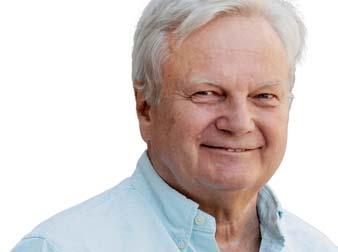
Back in 2020, DNV released a report on battery safety prepared in collaboration with the Norwegian, Danish and US maritime authorities, battery manufacturers, system integrators, suppliers of fire extinguishing systems, shipyards and shipowners. The report’s recommendations included research-based ventilation system design requirements that stipulate the appropriate size and type of system based on a vessel’s battery installation.
Julien Boulland, Global market leader for sustainable shipping, Bureau Veritas Marine & Offshore, notes that as per BV rules, batteries must be subjected to a series of tests to measure their tolerance and the point where they would enter thermal runaway. “Those tests are rigorous and comprehensive for the series, including external short circuit, impact, crush, drop test, thermal abuse, overcharge, forced discharge.”
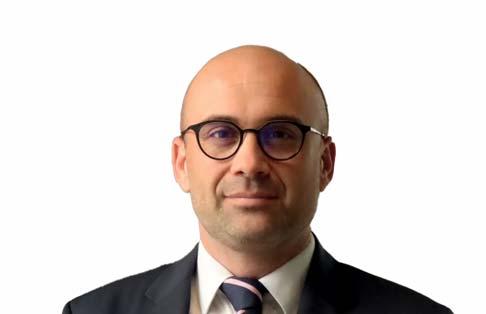
With fast-paced technology development, some battery chemistries that were previously considered less safe are now recognised as safe, due to better temperature control, for example. As a result, more and more chemistries are considered.

“Battery chemistry is an area under constant development, and these new types of batteries (such as solid state, lithium sulfur, etc.) will definitely provide benefits to the shipping industry, provided they pass the rigorous tests.”

Mejdi Kammoun, ABS, Principal Engineer, Corporate Technology, says more designers and operators and taking


an interest in fully-electric vessels using high-efficiency energy storage as the main power source onboard. He says new technologies including metal-air batteries, REDOX flow batteries, sodium metal chloride batteries and solid state batteries have the potential to replace the liquid electrolyte used in lithium-ion batteries, and in the process offer increased energy density and reduced risk.
Solid state batteries, for example, have solid electrolytes that are not prone to thermal runaway, and they are being tested with several different electrode and electrolyte materials, with lithium metal being a popular anode due to its high energy density. These various new chemistries are in different stages of research, he says, but they hold the potential for battery systems to become more practical and widespread in maritime applications in the future as the maritime industry further electrifies.
“These new battery designs are currently undergoing finetuning at the prototype stage for various components such as battery cells, modules, packs, and battery management systems before entering mass production. We estimate that with the necessary testing, production and regulatory process, these new technologies could be widely available for marine applications by 2030.”
It is possible that new battery technologies may initially be more expensive than current Lithium-ion batteries due to the development of new materials and the need to scale up production. However, as the technology matures and production scales up, costs are expected to decrease over time. Additionally, some new battery technologies such as, sodium-metal, REDOX flow batteries and metal air batteries have the potential to significantly reduce the production cost by using abundant material in their designs. ABS recently agreed a sponsorship program with Texas A&M Engineering Experiment Station to research topics including vessel electrification using battery technology to underscore and broaden its own research efforts.
“Together, these new technologies are a potential game changer in the application of batteries at sea,” says Kammoun. “By combining the advantages of longer lifespan, greatly improved energy capacity and an improved safety profile, they have the potential to accelerate the energy transition in the maritime industry, supporting shipping’s global decarbonization goals.”
BATTERIES & ELECTRIFICATION 34 | JULY/AUGUST 2023For the latest news and analysis go to www.motorship.com
8 Left to right: Julien Boulland, Global market leader for sustainable shipping, Bureau Veritas Marine & shore; Mejdi Kammoun, ABS, Principal Engineer, Corporate Technology; Green Shipping Programme Director at DNV, Narve Mjøs
gy y g p g
The use of onboard energy storage has grown rapidly over the last decade, and new chemistries are likely to be competing with lithium-ion batteries by around 2030
Left to Julien Bo m fo sustainab M Offshore; Kammou Corporat Technolo Green Sh Programm at N
AUTO INVESTMENT DRIVING ADVANCES IN BATTERY TECH
Developments in battery chemistry targeted aim to boost power density, increase longevity and reduce risk
Thermal runaway, a main cause of fire in electric vehicle (EV) batteries, has been the target of research by LG Chem. The resulting fires can be difficult to extinguish with water, because lithium-ion batteries have high reactivity to water. LG Chem has therefore developed a plastic battery pack that can delay thermal runaway in electric vehicle batteries.
The plastic consists of various material groups such as polyphenylene oxide, polyamide, and polybutylene terephthalate. As well as being flame-retardant, the new material maintains its shape despite temperature changes.
According to LG Chem’s in-house test results, the material can block flame propagation caused by thermal runaway more than 400 seconds at 1,000 degrees. This is 45 times better than general flame-retardant plastics.
LG Chem is also expanding production of its single-crystal high-nickel cathodes, made from single particles of several metals such as nickel, cobalt, and manganese. These cathodes can help boost battery lifespan by over 30% and increase capacity by at least 10%.
Battery materials company Sila says graphite anodes and simple silicon compounds (Si, SiO, SiO2) for lithium-ion batteries have reached their energy limit. The company has released Titan Silicon which it says can deliver up to 100 extra miles for some EVs. Battery charging time from 10% to 80% can be achieved in 20 minutes, and the technology results in a 15% reduction in battery weight.
ProLogium has developed a large-footprint lithium ceramic solid-state battery, following the release of a solidstate battery with a 100% silicon oxide anode last year. The company says increasing battery size to reduce the number of cells in a pack is an effective optimisation strategy and cites the current trend of cylindrical battery dimensions transitioning from 21 x 70mm to 46 x 80mm.
While a solid electrolyte allows faster movement of ions and greater tolerance of high voltages and temperatures, the technology has been associated with shorter battery life. Solid electrolytes repeatedly expand and contract as the battery charges and discharges which can create cracks that inhibit the movement of ions between the cathode and anode. Toyota has announced a newly discovered technology to overcome this challenge and is striving for commercialisation in 2027-2028. The company also says it has the technology for solid-state batteries with a range of 1,200km that can charge in 10 minutes or less.
Battolyser Systems has installed its first industrial-scale Battolyser system at the RWE Magnum power plant in the Netherlands. A Battolyser is a combination of a battery and a hydrogen generator (electrolyser) in one device. As soon as the system's battery functionality is charged, the Battolyser can use the excess electricity to split water into hydrogen and oxygen.
Research into battery chemistry continues, and scientists at the Argonne National Laboratory in the US have developed a new electrolyte for lithium metal batteries (with anodes made of lithium metal in place of the graphite normally used
in lithium-ion batteries). The new fluorinated cation electrolyte could greatly increase range and reduce costs and is also non-flammable.
In lithium metal batteries, the electrolyte is a liquid consisting of a lithium-containing salt dissolved in a solvent. While it can deliver more than double the energy density possible with a lithium-ion battery, performance diminishes within less than a hundred charge-discharge cycles because the electrolyte does not form an adequate protective layer on the anode surface during the first few cycles. This layer allows lithium ions to freely pass in and out of the anode to charge and discharge the battery. The new fluoride solvent maintains a robust protective layer for hundreds of cycles.
In testing with laboratory cells, the new electrolyte has retained stable energy storage capacity for 400 chargedischarge cycles at minus 4oF. Even at that sub-zero temperature, the capacity was equivalent to that of a cell with a conventional carbonate-based electrolyte at room temperature. The development is expected to therefore overcome the current problems experienced when charging electric vehicles in cold regions and seasons.
Researchers at the Illinois Institute of Technology and the Argonne National Laboratory have developed a lithium-air battery with the solid ceramic polymer electrolyte that can potentially boost the energy density by as much as four times that of lithium-ion batteries. It can operate with oxygen supplied by air from the surrounding environment. The researchers say the technology could be transformative for electrifying transportation, especially heavy-duty vehicles such as aeroplanes, trains, and submarines.

BATTERIES & ELECTRIFICATION For the latest news and analysis go to www.motorship.com JULY/AUGUST 2023 | 35
8 Mohammad Asadi, assistant professor of chemical engineering at Illinois Institute of Technology, has published a paper in Science describing the chemistry behind his novel lithium-air battery design
SEATECH PROJECT DRIVING NEW DATA MODELLING ADVANCE
The digital twin and data science environment being developed by the SeaTech Consortium for the testing of a dynamic wing and new engine control technology will ultimately pave the way for the testing of other technologies

8 The SeaTech project has included the development of a digital twin and comprehensive data science environment to predict the performance of the systems and their lifecycle costs
The EU-funded SeaTech project began in 2019 with the aim of combining bow-mounted foils with new, sophisticated control systems for a Wärtsilä dual-fuel 31 engine to allow the engine to work in tandem optimally with the foils.
The SeaTech engine is an ultra-high energy conversion, dual-fuel engine supported by a precisely controlled combustion process to reduce emissions. The propulsion innovation consists of a bow-mounted bio-mimetic dynamic wing capturing wave energy to create extra propulsion thrust. This reduces required engine power whilst also dampening undesirable ship motions such as rolling and pitching in high or moderate wave conditions.
The project is on-going and expected to lead to emissions reductions of 30% or more when using both the engine technology, running on LNG, and the dynamic wing. Part of the development work, along with engine and large-scale model testing, has involved the development of a digital twin and comprehensive data science environment that is being used to predict the performance of the systems and their lifecycle costs.
Key to that development was the desire to create something with the flexibility to evaluate other technologies in the future. The shipping industry needs energy efficiency and emission reduction technologies to achieve the ambitious emission reduction targets being set, and this means technologies that have been developed under experimental or laboratory conditions just like the SeaTech project, says Professor Lokukaluge Prasad Perera from the Arctic University of Norway.
“The digital twin framework that we are working on is open for integrating additional energy efficiency and emission reduction technologies into ocean-going vessels. It allows for the energy efficiency and emission reduction technologies that are under laboratory or model scale conditions to be integrated into a data science environment to quantify their performances. Therefore, shipowners can use it to decide which technologies can achieve the respective emission reduction targets. That way these technologies can come to the market sooner rather than later.”
Engine modelling
In the SeaTech project, the baseline for comparison is a diesel engine that is similar to the SeaTech engine. Both fuel consumption and emissions for a selected vessel with a diesel engine and a SeaTech engine with a dynamic wing are also considered for a life cycle cost analysis (LCCA) based on the data science established. The LCCA for the engine includes construction costs, operational and maintenance costs, and disposal costs. The respective fuel costs and possible costs due to emissions are also included in the LCCA.
“We have estimated that a 39% GHG emission reduction and up to a 22% fuel efficiency can be achieved under more optimal operational conditions by replacing LNG with diesel - this without considering the efficiency of the SeaTech engine, but just a dual-fuel engine,” says Perera. “Therefore, at the end of the project, I would assume we would achieve beyond 30% fuel reduction. This is not an unrealistic number since we are integrating two innovations, the SeaTech engine and the dynamic wing.”
DESIGN FOR PERFORMANCE 36 | JULY/AUGUST 2023 For the latest news and analysis go to www.motorship.com
The SeaTech project has developed several models for the project. “The models bring confidence to predict full-scale efficiencies, but that can be slightly higher in some situations. Therefore, we always conduct full-scale or large model-scale experiments to verify the model predictions. When it comes to LCCA, we are often deal with full-scale data, but when such data are not available, we are forced to use model-scale data. That is an acceptable approach in LCCA.”
Wave modelling
As the SeaTech project involves a wave harvesting device (the dynamic wing), it brings value when a vessel is navigating in wave fields to harvest energy. That means vessels with a dynamic wing should optimally navigate in relatively high sea states.
Part of the SeaTech research has included the development of suitable wave models, as ship length significantly influences the effectiveness of the wing in different operating conditions. The percentage foil retraction is also a significant factor in operating bow foils with a large variation depending on ship heading and encountered sea state. The researchers have therefore developed a holistic approach to evaluating route and ship specific energy savings.
Accurate assessment of wind, wave and current effects are critical to the process. Perera says that existing ship performance and navigation data sets have been collected by ocean going vessels but not necessarily utilised properly. Existing mathematical models are inadequate and cannot accommodate such data sets. Hence the need to develop a data science environment that can utilise all the required data sets and apply advanced data analytics such as digital twin concepts. This has enabled the researchers to begin quantifying technology performance in a way that can also be fed into the LCCA modelling.
Interaction modelling
The engine and foil interaction has also been a key part of model development. Because they interact, they should be studied in the same data science environment to achieve the desired accuracy for shipowners to base their decisions. The researchers have therefore combined analysis of realistic head wave conditions on both innovations within the one model framework.
The same thrust and ocean wave conditions have been applied to the engine and the wing and the data sets collected from the engine testing platform have been integrated with propellor characteristics and analysed using machine learning and artificial intelligence algorithms to develop the digital twin.
The digital twin has developed a hybrid engine-propeller combinator model using both theoretical calculations from hull design as well as data driven calculations from ship performance and navigation data sets to compare their performance in a single model framework. This has been used to establish the basis for identifying optimal vessel navigation and ship system operational conditions, in particular the various wave and thrust conditions that are optimal for a given test vessel.
Optimal wave conditions will vary depending on vessel size and length. Since ocean waves can consist of a mixture of different wave heights, lengths, and directions, the situation can be complicated, says Perera. “We have considered a mixture of such head waves, as a wave profile, for a selected ship by assuming it would encounter them throughout the engine’s lifetime (around 20 years). So based on such a wave profile, the engine operating conditions can be calculated and then emissions can be calculated.”
LCCA analysis
The LCCA analysis of the engine indicates that operation hours, engine loads and fuel costs are major contributing factors in determining operating costs and therefore influence the total life-cycle cost of the engine.
“Advanced data analytics and LCCA calculations complement to each other and include dynamic interactions involving uncertainty analysis of utilising new technologies,” says Perera. “This approach opens a path for integrating and evaluating energy efficient and emission reduction technologies in a data science environment. Appropriate technologies can be compared against their energy efficiency gains with respect to existing vessel technologies, especially in engine and propulsion systems.”
It is important to compare the total cost performance of the SeaTech engine with that of a diesel engine in a similar context (e.g., power output, engine speed and operational profile), says Perera, and that is a data-intensive process that is still on-going with more wave models being developed and assessed.

Market potential
“For the Seatech project, the underlying vision is that within five to eight years, it will be possible to bring to the market two symbiotic solutions that can make shipping radically greener in light of tightening regulations and initiatives,” says Perera. “The envisaged primary target market is short-sea shipping, followed by deep-sea vessels. Short-sea shipping plays a significant role for Europe, representing one third of intra-EU exchanges in terms of ton-kilometres. It is also a segment in which early innovation adopters are easier found than in the more conservative deep-sea market, which is at the same time subject to less strict emission regulations.
“Assuming only 10% of EU short-sea vessels would be retrofitted with SeaTech, this would result in CO2 savings of 32.5 million tons annually, which equals the emissions of 200,000 passenger cars per year,” says Perera. “It is expected that the SeaTech product will generate a cumulative net profit of EUR 820 million within five years after entering the market in 2025.”
DESIGN FOR PERFORMANCE For the latest news and analysis go to www.motorship.com JULY/AUGUST 2023 | 37
8 Professor Perera plans to exceed fuel efficiencies of 30% before the end of the project
NEW CHAPTER IN VEHICLE CARRIER EVOLUTION
Testament to the reach and resolve of the Japanese shipping industry, the essential trading tool of the world’s third largest economy, the NYK Group has taken delivery of the initial vessels in a major programme of LNG-fuelled pure car/truck carrier(PCTC) construction
Over the course of the first half of this year, the 7,000CEU (car equivalent unit)-capacity Jasmine Leader, Wild Rose Leader and Freesia Leader have been handed over by China Merchants Jinling Shipyard (Nanjing), where a fourth sister is in hand. A further 12 PCTCs of similar intake are on order to NYK account at Japanese yards for delivery from 2025 onwards.
One of the main features of the Jinling series is a hybrid control system with battery power, which affords a peakshaving capability, obviates or reduces the risks of blackout, and also supports bow thruster operation.
NYK’s first LNG dual-fuel, deep-sea vehicle carriers, the 7,000CEU Sakura Leader and Plumeria Leader, were brought into service during 2020 and 2022, respectively, from Shin Kurushima Toyohashi Shipbuilding. The shipowner plans to have a total of 20 LNG-powered PCTCs in its fleet by 2028, indicating that contracts for another two newbuilds are in the offing.
The adoption of LNG as the main fuel, in conjunction with hull form optimisation and other fuel economy measures, renders the Jasmine Leader class some 40% more energy efficient than conventionally HFO-powered ships in the NYK fleet. The ships are Tier III NOx-compliant in gas mode, and the efficiency level takes the vessels well beyond current and future Carbon Intensity Indicator (CII) requirements and past IMO’s present greenhouse ga s(GHG) emission target for 2030.
NYK has set a long-term target of net-zero emissions of GHG by 2050 from its ocean-going fleet, which encompasses all main types of merchant vessel. LNG is seen as a transition, low-carbon fuel until the focus switches to zero-emission ships. Ammonia and hydrogen are two of the main options under consideration for possible application from 2029 onwards.
Significantly, NYK completed the concept design of an ammonia-ready PCTC in conjunction with Finnish consultancy Elomatic and Monohakobi Technology Institute (MTI) of Tokyo in March 2022. Furthermore, the LNG-fuelled 7000 PCTC series developed by Shanghai Merchant Ship Design & Research Institute (SDARI), and on which the new Jasmine Leader class is based, has provided the platform for an ammonia-fuelled version, for which SDARI has recently secured DNV Approval in Principle(AiP) certification.
Jasmine Leader is powered by a seven-cylinder example of the X62DF-2.1 two-stroke, low-pressure dual-fuel engine designed by Winterthur Gas & Diesel(WinGD) and manufactured in China by CSSC-MES Diesel Co, with direct drive to a fixed pitch propeller. The installation has the distinction of being the first-ever worldwide to apply X-DF2.0 iCER technology, designed to cool and recirculate part of the exhaust gas through a low-pressure path in gas mode. The iCER configuration is claimed to reduce methane slip by up to 50% while yielding appreciable energy gains.
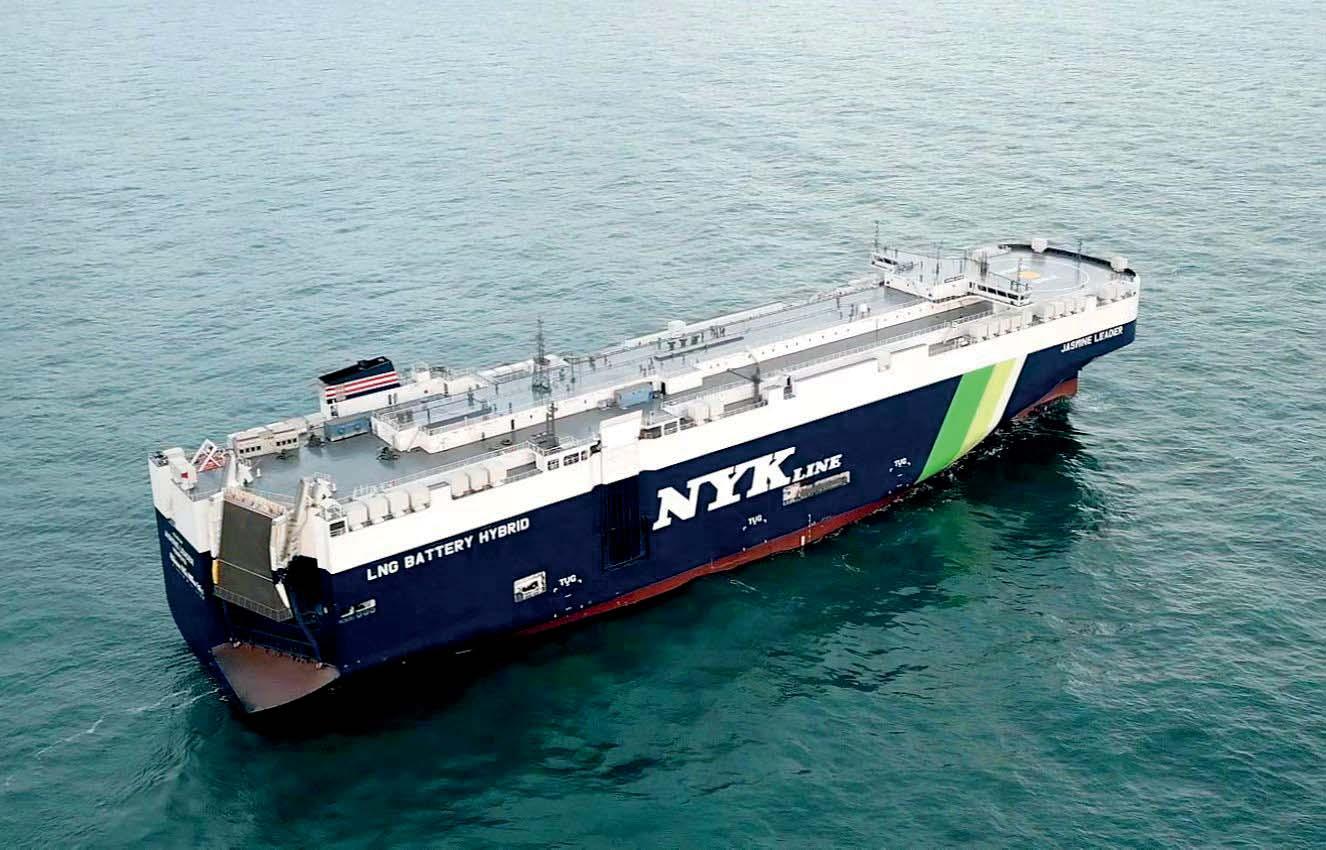
SHIP DESCRIPTION 38 | JULY/AUGUST 2023 For the latest news and analysis go to www.motorship.com
8 Jasmine Leader inaugurated a major new stage of PCTC fleet development by NYK, using LNG as a ‘transition’ fuel
The main engine is fitted with a MET71MB turbocharger developed in Japan by MHI-MME and tailored to the iCER system. Particular consideration has been given to dealing with the liquid droplets and fuel residue that could be introduced from the intake side.
The 7X62DF-2.1 ‘cathedral’ engine, representing the largest bore size supplied to a PCTC, has been specified for a maximum continuous output of 15,400kW at 103rpm, slightly derated from the model’s nominal MCR of 16,695kW. The power concentrated in the LNG-ingesting design, ensuring a speed of some 19.5 knots, is in excess of that provided to the seminal Sakura Leader, which is equipped with an 8X52DF unit rated for 11,920kW at 105rpm.
Besides the prime mover, the WinGD LNG-battery ‘package’ contract for the Jasmine Leader, as with the subsequent sisters, comprised shaft generator, 570kW energy storage system, DC(direct-current) links and bow thruster drive. Recourse was made to the Japanese company Nishishiba for the 1,240kW in-line shaft generator. The first-of-class also provided the opening reference for WinGD’s proprietary X-EL Energy Management system. This is a new battery-hybrid power integration and sustainability service which melds the two-stroke engine control with the electrified vessel power system, optimising energy flow and efficiency.
The PCTCs also employ the Swiss two-stroke specialist’s WiDE engine monitoring and diagnostics, whereby a digital twin of the specific system compares ideal, simulated behaviour with actual performance based on vessel operation and sea-going conditions. This allows for anomalies to be detected early, diagnosed and communicated to crew and shoreside support staff with advice for troubleshooting and maintenance.
LNG dual-fuel capability extends to the ship’s auxiliary outfit, which is composed of three main gensets driven by HiMSEN four-stroke engines. The eight-cylinder H22CDF units emanate from the Hyundai Group and are individually rated at just over 1,600kW, primarily to provide manoeuvring power and meet the in-port electrical load, with the shaft alternator supplying the ship’s net when on passage.

Two 2,000m3 LNG fuel tanks are located on the tank top, immediately forward of the engine room bulkhead.
The hull breadth of 38m is some 6m greater than that of ships built to the constraints governed by the Panama Canal prior to its expansion, while the length overall at just under 200m ensures global trading versatility while meeting the physical restrictions imposed by many Japanese terminals.
Cargo space subdivision and loading flexibility in the Jasmine Leader type is achieved by 12 ro-ro vehicle decks, of which four are hoistable, and wherein four provide the clearance and strength to bear shipments of trucks, buses, agricultural, construction and mining equipment and machinery, heavy plant and trailer-borne project cargo, containers and hazardous freight. The increased average height and weight of cars and the growing transportation
activity involving electric vehicles is reflected in the internal configuration and outfit of the new generation of PCTCs.
The genre’s trademark starboard quarter ramp is of 150t capacity and is complemented by a 20t side ramp, with cargo distribution effected by means of an internal ramp system. The powering arrangements are focused on electric motors rather than hydraulic cylinders. The entire cargo access solution was delivered by Cargotec’s Macgregor division, and includes the latter’s patented Load Monitoring System, which has increased the safe working load of the quarter ramp by up to 50% without additional structural weight.
Initial shipments from Japan by Jasmine Leader and second-of-class Wild Rose Leader involved vehicles produced by Mazda Motor Corporation and Honda Motor Co. The new vessels from Jinling are registered under the Liberian flag and husbanded by Singapore-domiciled NYK Shipmanagement.
Beyond fourth-of-class Sumire Leader, which is nearing completion in China, NYK’s PCTC build programme currently encompasses six ships booked at Shin Kurushima Toyohashi and six from Nihon Shipyard. All 12 are in the 7,000CEU category, employing a similar 199.9m x 38m hull envelope as the Jinling quartet, and specified with WinGD LNG dual-fuel propulsion machinery. The domestically-built tonnage is scheduled to be delivered at regular intervals between the latter stages of 2024 and 2028.
PRINCIPAL PARTICULARS - Jasmine Leader
8 The new car carriers for NYK will feature cutting-edge emissions reduction technology, energy management and digital optimisation solutions
19.5kts Main gensets 3 x 1,600kW
Shaft generator 1,240kW Class DNV
Class notations 1A Car carrier, BIS, battery(Safety), BWM(T), COAT-PSPC(B), DG(P), E0, Gas fuelled LNG, LCS, MCDK, NAUT(OC), Recyclable, TMON(oil lubri-cated), ER(EGR, Tier III) Flag Liberia
For the latest news and analysis go to www.motorship.com JULY/AUGUST 2023 | 39
SHIP DESCRIPTION
‘‘
One of the main features of the Jinling series is a hybrid control system with battery power, which affords a peak-shaving capability, obviates or reduces the risks of blackout, and also supports bow thruster operation
Length
Length
195.6m Breadth,
38.0m Depth 15.5m Draught 10.1m Gross tonnage 71,846t Deadweight 19,359t Cargo capacity 7,100CEU Cargo
Main engine
Speed
overall 199.9m
bp
moulded
decks 12
power 15,400kW
•Bilge water monitors & filtration
•Seals and bearings
•Dry dock services
•Underwater repairs
•Additives to prevent leakage
•Marine engineering consultancy







•Project management
•Service contracts
Maintaining the highest possible standards for our customers. Service, upgrades and retrofits.
● Governors / Actuators
● Support for all Viking based products and our new simple to install Viking352G upgrade pack (below)

● Spare parts & Service
● OEM quality overhauls and service exchange units

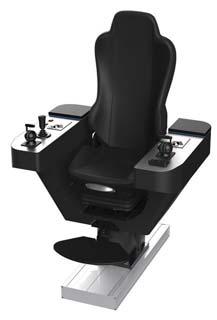
● Propulsion Controls
● Generator Controls
● Power Management

● Turbocharger Condition Monitoring systems

Regulateurs Europa Limited Port Lane, Colchester. CO1 2NX UK


Phone +44 (0)1206 799556
Fax +44 (0)1206 792685Email sales@regulateurseuropa.comWeb www.regulateurseuropa.com
Is your damper providing engine protection?
Torsional Vibration Dampers



Maintenance and Repair of Crankshaft Torsional Viscous Vibration Dampers

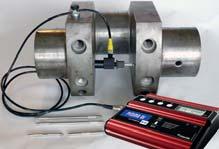
Tel: +44 (0)1422 395106
Fax: +44 (0)1422 354432 davidwhitaker@metaldyne.com www.metaldyne.co.uk







Formerly Simpson Ind - Holset Dampers
Reliable measurement, optimization and monitoring solutions for fuel oils. info@aquametro-oil-marine.com www.aquametro-oil-marine.com



LUBRICANTS


TRUSTED FOR GENERATIONS
Explore our range of innovative, high performance and Environmentally Acceptable Lubricants, delivered with an unparalleled level of personal service.
more information please contact us at Vickers Oils
40 | JULY/AUGUST 2023For the latest news and analysis go to www.motorship.com PRODUCTS & SERVICES DIRECTORY BRIDGE EQUIPMENT Tel: +49-2938-98769-0 info@chair-systems.com http://www.pilotchairs.com
COMFORTABLE 9
9 Adjustable armrests 9 Variable seat
9 Infinitive height
of the seat top 9 Seat angle adjustment 9 Length adjustment
the seat
NAUTIC PRO THE
High quality upholstery with individual logo stitch (optional)
depth
adjustment
of
top
DAMPERS CONTROL & MONITORING BEARINGS CONTROL & MONITORING EMISSION CONTROL
FUELS & OILS
atzmartec.com Experts in marine engineering equipment
6 Clarence Rd, Leeds, LS10 1ND,
Tel: +44 (0)113 386 7654 Fax: +44 (0)113 386 7676 Email:
Web:
For
UK
inbox@vickers-oil.com
www.vickers-oil.com
MAINTENANCE 30 60 PROPULSION AEGIR-MARINE, BUILT ON SERVICE Call us at +31 343 432 509 or send us an email: info@aegirmarine.com
11 13 TO JUNE 2024 Southampton United Kingdom Seawork directory indd 1 25/07/2023 11:27
For more information visit: seawork.com contact: +44 1329 825335 or email: info@seawork.com












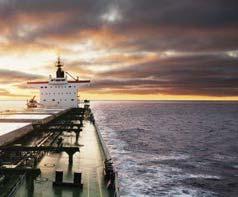






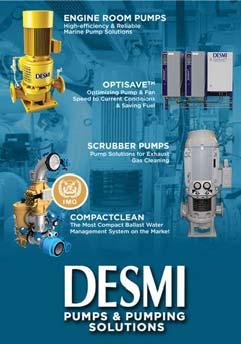


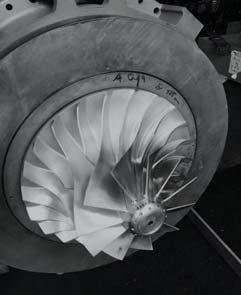


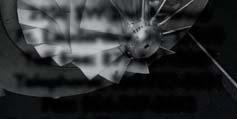







For the latest news and analysis go to www.motorship.com JULY/AUGUST 2023 | 41 PRODUCTS & SERVICES DIRECTORY SPARE PARTS
quality underwater repairs Hydrex offers underwater repair solutions to shipowners around the globe. Our experienced teams are qualified to perform all class-approved repair procedures in even the harshest conditions. Hydrex headquarters Phone: +32 3 213 53 00 (24/7) E-mail:hydrex@hydrex.be www.hydrex.be Hermann-Blohm-Str. 1 · D-20457 Hamburg Phone +49 40 317710-0 · Fax +49 40 311598 E-mail info@nds-marine.com www.nds-marine.com Our reliability.Your move. Big enough to handle it Small enough to care Your Ship Repair Yard in Lisbon Estaleiro da Rocha Conde de Óbidos 1399 –036 Lisboa –PORTUGAL Tel. Yard (+ 351) 213 915 900 www.navalrocha.com navalrocha@navalrocha.pt TESTING & ANALYSIS SHIPREPAIR TEMP CONTROL TURBOCHARGERS WASTE WATER ENGINEERING CO. LTD. TEMPERATURE CONTROL VALVES Comprehensive range of 3-way Valves suitable for Fresh Water, Lubricating Oil and Sea Water Systems Wide choice of materials. Robust construction, low maintenance, simple to use and cost effective method of temperature control Tel: +44 (0) 1727 855616 Fax: +44 (0) 1727 841145 E-mail: Sales@waltonengineering.co.uk Website: www.waltonengineering.co.uk DIRECT • PNEUMATIC • ELECTRIC • GAS PRESSURE OPERATED VALVES Start Systems for Two and Four-Stroke Engines Please visit: www.seitz.ch LABORATORY ANALYSIS FOR THE MARINE INDUSTRY Tel: +44 (0) 1256 704000 Email:enquiries@spectro-oil.com Web: spectro-oil.com For more information contact us Phone: +44 141 880 6939 Email: mrhmarineoff@btconnect.com Or visit: www.mrhmarine.com Jets AS Vacuum Toilet Systems and STP’s, Jowa Water Handling Systems, Libraplast A60 Doors, Metizoft Green Passport Solutions, Modular Wet Units, Vacuum Pipe De-Scale Solutions and all kinds of bathroom and plumbing accessories you may require for any vessel 10 30 60 70 70 2950 SW 2nd Avenue Ft. Lauderdale, FL 33315 Toll free: 877-887-2687 Telephone: 954-767-8631 Fax: 954-767-8632 Email: info@turbo-usa.com www.turbo-usa.com Installing Turbocharger Confidence TURBOCHARGERS ABB Turbo MarineCare Predictability in a changing world Full range of CP Propulsion Systems • Reduction Gearboxes 150 • 12000 kW • PTO - PTI and 2 - Speed solutions • 3 - 4 and 5 bladed CP Propellers Ø1-6m dia • Fifth Generation Electronic Remote Controls • Nozzles NACA 19A Finnøy High Speed Finnøyveien 195 6487 Harøy NORWAY (+47) 712 76 000 post@finnoygear.no PUMPS PROPULSION
High
CATHEDRALS AND STONE CRUSHERS
The international magazine for senior marine engineers
EDITORIAL & CONTENT
Editor: Nick Edstrom editor@mercatormedia.com
Correspondents
Please contact our correspondents at editor@motorship.com
Bill Thomson, David Tinsley, Wendy Laursen
SALES & MARKETING
Brand manager: Sue Stevens sstevens@mercatormedia.com

Tel: +44 1329 825335
Production
David Blake, Paul Dunnington production@mercatormedia.com
EXECUTIVE
Squeezing more power out of ship engines continued to dominate the industry in the July and August 1973 issues of The Motor Ship, as engine designers continued to increase size and power.
The July issue included a supplement on high powered medium speed propulsion, while the August issue contained an equivalent roundup of the traditional low speed engine. Typical of the former was the Pielstick PC4, on which our predecessors reported trials at the IHI Aioi works in Japan of an 18,000 bhp engine, the first 12-cylinder version of the design, although 16 and 18 cylinder variants were to be available. The market for the new engine type was considered to be broad – from high speed ferries to container ships and tankers.
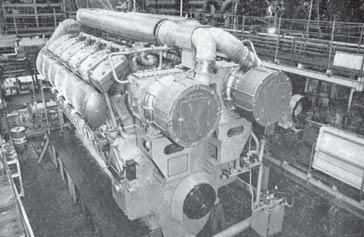
High power continued to dominate the headlines concerning two-stroke units. What was thought to be the most powerful diesel engine yet built was fitted to the 280,000 dwt ore/oil carrier Svealand which had recently been completed at the Eriksberg Mek Verkstads yard for the Swedish Bröstrom Group. It had been chartered by a Japanese steel company to carry iron ore from Brazil, with another charter for crude oil from the Gulf to Europe. Dry cargo was carried in five centre holds of 155,000m3 volume with 14 side tanks and two slop tanks, total capacity 329,000m3 for oil. The main engine was a B&W 10-cylinder K98GF of 41,000 bhp MCR at 100 rpm. This was supplemented by an AEG/Kanis steam turbo alternator or 875kVA and three Bergen gensets each producing 920kVA.
Unusually, in view of the industry’s perceived move towards medium speed propulsion, a new cruise vessel described in the July 1973 issue opted for two Sulzer 9RD68 two-stroke units. The 24,200gt Vistafjord, built by Swan Hunter for Norwegian America Line, the first UK-built passenger liner for several years, was designed for world-wide cruising. The whole of the superstructure – about 600t in weight – was constructed in aluminium and joined to the steel hull using bolts with neoprene sheet separating the two metals. The twin-screw propulsion
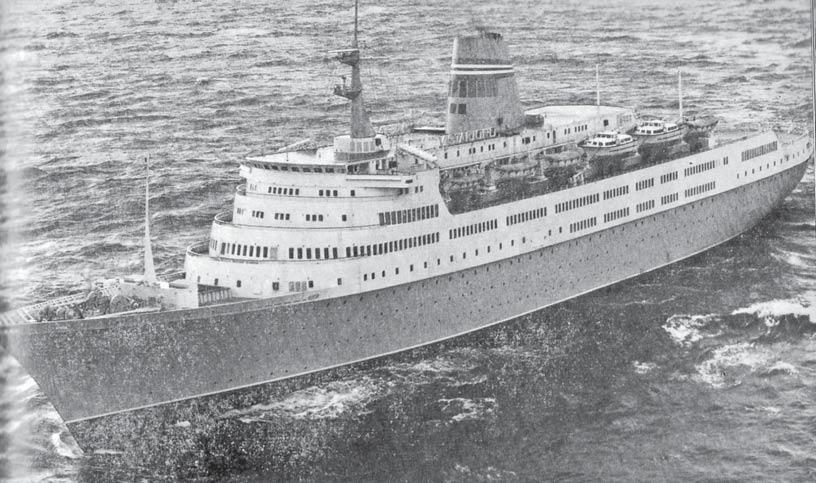
system offered a maximum speed of 22.5 knots with each engine, directly coupled to 4.8m diameter four blade propellers, producing 12,000 bhp at 150 rpm though normal operation called for a 20 knot service speed, at 70% power rating.
In August 1973 it was interesting to note that, in the editorial leader, terms employed for large low speed engines such as ‘cathedrals’ or ‘stone crushers’ were regarded pejoratively. But despite the perceived insults, such engines were continuing to hold their own in the market against the apparently more sophisticated four-stroke competition and the traditional steam turbine. However, a cautionary note was sounded regarding an impending ‘energy crisis’ which was seen as likely to drive the marine propulsion industry towards increased use of distillate fuels and gas turbines. This fear was countered by an expectation that diesel engine developments would be driven by higher costs to significant improvements in fuel consumption alongside higher power outputs, greater reliability and reduced maintenance.
The main ship descriptions, for a 26 knot 1887 TEU MOL container ship and a 159,250 dwt bulk carrier, held firm to the low-speed engine option, with, respectively, twin-screw Mitsui-B&W 34,800 bhp 12K84EF and single 30,400 bhp 8K98EF power. However, a novel arrangement has been chosen for another vessel described in August 1973 – a single-screw 5061 dwt bitumen tanker, Framnas, with four high speed Hedemora V8A12 main engines, each rated 800 bhp at 1200 rpm. As well as main propulsion, two engines drove cargo pumps and two drove alternators.
Chief Executive: Andrew Webster awebster@mercatormedia.com
TMS magazine is published monthly by Mercator Media Limited Spinnaker House, Waterside Gardens, Fareham, Hampshire PO16 8SD, UK
t +44 1329 825335
f +44 1329 550192
info@mercatormedia.com www.mercatormedia.com
Subscriptions
Subscriptions@mercatormedia.com Register and subscribe at www.motorship.com
1 year’s digital subscription with online access £222.00
For Memberships and Corporate/multi-user subscriptions: corporatesubs@mercatormedia.com
42 | JULY/AUGUST 2023For the latest news and analysis go to www.motorship.com 50 YEARS AGO
© Mercator Media Limited 2023. ISSN 0027-2000 (print) ISSN 2633-4488 (online). Established 1920. The Motorship is a trade mark of Mercator Media Ltd. All rights reserved. No part of this magazine can be reproduced without the written consent of Mercator Media Ltd. Registered in England Company Number 2427909. Registered office: Spinnaker House, Waterside Gardens, Fareham, Hampshire PO16 8SD, UK
8 The low-speed engined cruise ship Vistafjord Inset:The Pielstick 12PC4 engine on test at IHI

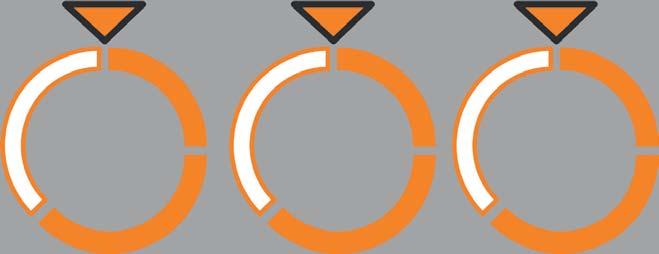
MOTORSHIP MARINE TECHNOLOGY THE Contact us today Reach industry professionals with The Motorship Promote your business to the right audience in the right place at the right time. Engage with our audience of senior marine engineers, from ship owners and commercial partners a wide range of opportunities for campaign delivery. We Motor Ship’s valued content is relied upon by shipping professionals and is delivered through multiple channels. Sue Stevens, Brand Manager t: (+44) 1329 825 335 e: sales@motorship.com www.motorship.com MAGAZINE RECIPIENTS DECISION MAKERS PAGEVIEWS PER MONTH 12,92572%40,330
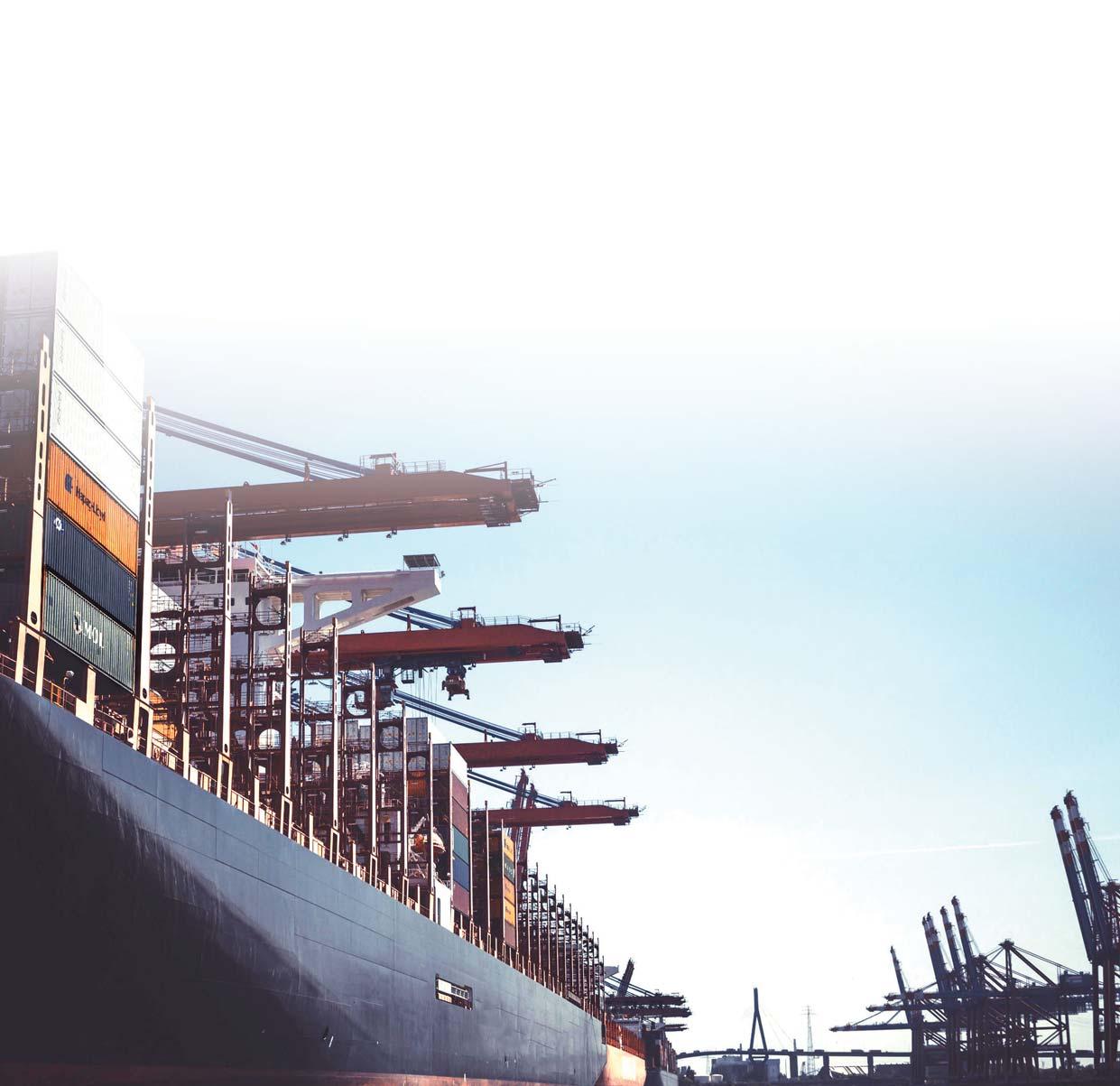






















44TH 23 TO NOV 3 21 Hamburg Germany Propulsion stream | Alternative fuels stream | Technical visit Meet and network with 200 CEOs and technical directors from ship owning, operating and management policy makers, shipbuilding, fuel, equipment and technology suppliers. Visit: motorship.com/PFFBOOK Contact: +44 1329 825335 Email: conferences@propulsionconference.com #MotorshipPFF Keynote panel topic: The cost of decarbonisation & who is going to pay? Topics to discuss with the keynote panel will include carbon levy funding, funding for investment, national incentives, funding for new technology & hypothecation. Programme out now - Book now and save 20% Learn
Safety challenges for new technology LNG beyond transition Carbon capture Advances in lubrication Powering shipping’s emissions-cutting ambitions Gain insight from industry experts on: MOTORSHIP MARINE TECHNOLOGY THE Media partner: Media supporters:
from C-suite keynote panel
MODERATOR
Lars Robert Pedersen, Deputy Secretary General, BIMCO
Annika Kroon, Head of Unit D1 Maritime, European Commission
Simon Bennett, Deputy Secretary General, International Chamber of Shipping
Martin Kröger, CEO, German Shipowners’ Association (VDR)
Wolfram Guntermann, Director Regulatory Lloyd AG
ik Supported by: Sponsored by:
Markus Münz, Managing Director, VDMA Large Engines


















































































































































































